On Being Stoned
Charles T. Tart, Ph. D.
Chapter 11. The Body
THE HUMAN BODY is something that is treated with great ambivalence in our culture. On the one hand, it is a frail thing and a source of sin and evil; on the other, a glorious creation and source of joy. Some people neglect their bodies entirely; other focus on them to the point of pathology (hypochondriasis). Our attitudes about what we put into our bodies are also extremely ambivalent; we pump them full of every food fad that comes along, alcohol, stimulants, tranquilizers, and, for some, drugs such as marijuana. Some of the dangerous drugs we put in our bodies receive great praise (alcohol, as a prime example); others, shocked horror. As well as being a reference point for many of our experiences, the body is thus a focus of many ambivalent attitudes, and it is particularly interesting to see what the effects of marijuana intoxication are on the perception of one's own body.
We shall deal with changes in the perception of the body under three semi-distinct categories: (I) changes in the ordinarily perceived aspects of the body, such as its size and strength; (2) the body in motion; and (3) changes in the perception of the internal workings of the body, which are normally not in awareness.
CHANGES IN PERCEPTION OF THE ORDINARY BODY
Direction of Attention
Perception of one's body is more affected by the direction of attention during marijuana intoxication than ordinarily; a common effect is "If I am paying attention to some particular part of my body, the rest of my body fades away a lot, so the part I'm attending to stands out more sharply" (13%, 15%, 37%, 27%, 6%). About as common is "I lose awareness of most of my body unless I specifically focus my attention there, or some particularly strong stimulus demands my attention there" (13%, 24%, 39%, 17%, 5%). This latter effect is more common among Non-users of Psychedelics (p <.0005). Both effects begin to occur primarily at the Strong and higher levels of intoxication (2%, 19%, 29%, 26%, 7% and 3%, 17%, 28%, 20%, 14%, respectively). The older users do not need to be as intoxicated to lose awareness of their bodies if they are not focusing there (p < .05).This phenomenon manifests in more extreme form with "I have lost all consciousness of my body during fantasy trips, i.e., gotten so absorbed in what was going on in my head that my body might as well not have existed for a while," a common phenomenon (10%, 21%, 36%, 20%, 10%) of the very high levels of intoxication (1%, 7%, 19%, 27%, 29%), experienced less frequently by Daily users (p <.01, overall). An even more extreme version of this phenomenon, but still fairly frequent, is "I have lost all consciousness of my body and the external world, and just found myself floating in limitless space (not necessarily physical space)" (25%, 29%, 30%, 10%, 4%), which occurs at maximal levels of intoxication (1%, 2%, 11%, 21%, 31%). The younger users need to be more intoxicated to experience this (p <.05).
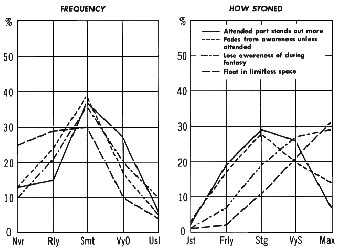 |
| Figure 11-1. AWARENESS OF ONE'S OWN BODY Note.—For guide to interpreting the "How Stoned" graph, see note on Figure 6-1. |
The relationships between these four phenomena dealing with awareness of the body are plotted in Figure 11-1. Totally losing awareness of the body and the world, and experiencing oneself floating in limitless space occurs less frequently than the other, less extreme ways of losing awareness of the body (p <.0005, overall). With respect to level of intoxication, the body fading from awareness unless attended to and the focused part of the body standing out more happen at essentially the same levels of intoxication. The two phenomena of totally losing awareness of one's body occur at higher levels of intoxication (p <<.0005, overall) than the previous phenomena, but these two do not differ from one another.
Given that the perception of one's body is highly affected by the deployment of attention while intoxicated on marijuana, what are some of the specific changes?
Pain
A common effect is "Pain is easy to tolerate if I keep my attention elsewhere" (21%, 10%, 34%, 13%, 12%), with the linked opposite effect, "Pain is more intense if I concentrate on it," which occur with essentially the same frequency (23%, 11%, 23%, 17%, 15%), an excellent illustration of the importance of deployment of attention. Both experiences occur at essentially the same Strong levels of intoxication (7%, 13%, 28%, 15%, 1% and 6%, 19%, 26%, 9%, 2%, respectively).The phenomenon of pain being more intense if concentrated on is affected by several background variables. It is reported more frequently by the younger users (p <.05), by the College-educated (p <.05), and by Non-users of Psychedelics (p < .05). The older users need to be more intoxicated to experience this (p <.05), while the Heavy Total lasers experience this at lower levels of intoxication than the Light or Moderate Total users (p <.05, overall).
Lightness and Heaviness
A common experience is "With my eyes closed, my body may feel very light or even feel as if I float up into the air when stoned" (16%, 16%, 41%, 19%, 8%), which begins to occur at Strong levels of intoxication (3%, 13%, 30%, 21%, 15%). According to my informants, having the eyes closed is not necessary to experience much lightness, but is necessary to feel as if one were actually floating. This experience is more common among the College-educated (p <.01).The opposite phenomenon, "My body feels abnormally heavy, as if it weighed much more" (26%, 31%, 31%, 7%, 5%), is fairly frequent, but does occur significantly less frequently than lightness (p <.005), albeit at essentially the same levels of intoxication (3%, 10%, 28%, 18%, 13%). Heaviness is reported as occurring more frequently by the younger users (#p <.05).
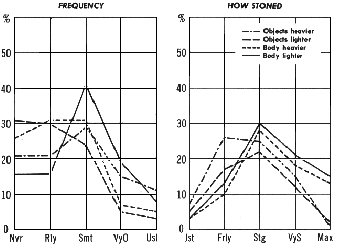 |
| Figure 11-2. PERCEIVED WEIGHTS Note.—For guide to interpreting the "How Stoned" graph, see note on Figure 6-1. |
It is of interest to compare these phenomenological increases and decreases in the weight of one's own body with those earlier mentioned for objects, namely, objects' seeming heavier and objects' seeming lighter, discussed in full in Chapter 8. Figure 11-2 compares all four phenomena. Objects seem heavier more frequently than lighter, but one's own body seems lighter more frequently than heavier. Further, increased heaviness is more frequently attributed to objects than to one's own body (p <.05), but lightness is more frequently attributed to one's own body than to objects (p <.0005).
In terms of levels of intoxication, overall differences among these four phenomena are quite significant (p <.0005). While the levels are not different for objects feeling lighter or heavier, or for the body feeling lighter or heavier, a higher level of intoxication is generally needed for the body to feel heavier compared to objects feeling heavier (p <.0005). The same is true for body vs. object lightness; the user must generally be more intoxicated for his body to feel light than for objects to feel light (p <.01).
Body Size
One's own body may change in perceived size: "My body feels larger than usual" occurs infrequently (37%, 21%, 29%, 9%, 1%), as does the opposite effect, "My body feels smaller than usual" (44%, 25%, 21%, 3%, 0%). Both may begin to be experienced at Strong levels of intoxication (1%, 9%, 21%, 23%, 4% and 1%, 7%, 17%, 18%, 3%, respectively, with many users not being able to rate these). The body's feeling smaller than usual is experienced more frequently by the College-educated (p <.05) than by the Professionals, and less frequently by Light Total users (p <.05, overall). Males need to be more intoxicated than Females to experience the body's feeling smaller (p <.05).Irritating Effect of Smoking
An infrequent effect is a direct physiological effect of the irritating components of marijuana smoke: "Smoking grass makes me cough hard while inhaling and holding my breath" (14%, 42%, 32%, 9%, 2%). Thus, frequently, marijuana smokers use water pipes or hookahs to cool the smoke and dissolve out some of the irritating ingredients. No rating of intoxication levels was asked for, as the quantity and quality of smoke inhaled seem to be the primary factor determining irritation, although some of my informants indicated that if they are fairly intoxicated or higher, they can ignore the irritation of harsh smoke more easily and so are less likely to cough. Note that this item was scored one point on the Validity scale if a user answered Never.Strength
A pair of experiences relate to strength: "I feel much stronger when stoned (regardless of whether actually physically stronger or weaker)" is reported infrequently (37%, 28%, 25%, 7%, 1%), with Heavy Total users experiencing this more often than Moderates (p <.05), and Moderate Total users experiencing it more often than Lights (p <.05). These feelings of strength begin occurring at Strong levels of intoxication (4%, 13%, 25%, 13%, 3%, with 43% not rating).The converse effect, "I feel much weaker when stoned (regardless of whether actually physically stronger or weaker)" occurs just often enough to be rated a common effect (27%, 21%, 33%, 11%, 6%), and occurs significantly more frequently than feeling stronger (p <.05), albeit at essentially the same levels of intoxication (5%, 17%, 25%, 14%, 6%).
Tremor
The final and quite infrequent effect on the ordinarily perceived body is "My muscles develop actual physical tremors (large enough to see visually)" (51%, 23%, 17%, 4%, 3%), which may occur at the Stronger and higher levels of intoxication in the minority of users who could rate this (1%, 7%, 11%, 14%, 11%).These last few phenomena bring us to a consideration of the moving body in contrast to the relatively static experiences above.
THE BODY IN MOTION
Relaxation and Restlessness
One of the most characteristic effects of marijuana intoxication is "I get physically relaxed and don't want to get up or move around" (1%, 3%, 24%, 49%, 23%), which typically begins to occur at Moderate levels of intoxication (12%, 37%, 29%, 12%, 8%). While this occurs primarily at the Fairly and Strongly levels for Occasional and Daily users, many Weekly users also indicate Very Strong and Maximal for this effect (p < .05, overall). One informant commented on this to the effect that marijuana is naturally tranquilizing; the Weekly user is busy learning about all the things he can do when intoxicated, the Occasional user hasn't learned to exert himself like the Weekly user to overcome this tranquilizing effect, and the Daily user has already explored what he can do and is content to be relaxed.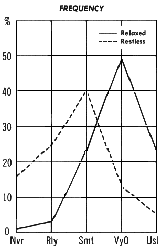 |
| Figure 11-3. DESIRE FOR MOVEMENT |
The opposite effect, "I get physically restless so that I want to move around a lot" is common (16%, 25%, 40%, 13%, 5%), more so in the young users and the College-educated, compared to the older users (p <.05) and the Professionals (p <.01). It also occurs at Fair to Moderate levels of intoxication (13%, 29%, 26%, 7%,5%). It occurs far less frequently (p <<<.0005) than feeling relaxed and not wanting to move, as shown in Figure 11-3.
Coordination
In spite of this tendency to sit around and relax, if the user moves about, he characteristically finds his movement seems exceptionally well coordinated: "When I move about or dance, my motions seem exceptionally smooth and well coordinated" (7%, 9%, 28%, 33%, 20%). This is reported as occurring more frequently by females (p <.05) and by Non-users of Psychedelics (p <.01). It begins to occur at Moderate to Strong levels of intoxication (7%,31%, 37%, 13%, 1%), with Weekly users needing to be more intoxicated than Occasional or Daily users for this (p <.05, overall).The converse effect, "When I move about or dance, my motions seem awkward and uncoordinated" is infrequent (25%, 31%, 27%, 8%, 5%). It may begin to occur from Moderate Levels of intoxication and higher (7%, 17%, 19%, 17%, 8%). It is reported as occurring less frequently by Light Total users (p <.05, overall), Occasional users (p <.05, overall), and Non-users of Psychedelics (p <.01). The Professionals need to be more intoxicated to experience this awkwardness (p < .05). It is an important research problem to determine whether this is an actual decrement in coordination or simply an altered perception of one's own movements, possibly related to time alterations.
A more extreme version of poor coordination is "My sense of balance gets very erratic, making it seem difficult to walk or even maintain a sitting position." This is a fairly frequent effect (29%, 35%, 28%, 6%, 1%) in that few users have not experienced it at all, but even fewer experience it Very Often or Usually. It is reported as occurring more frequently by females (p <.05). It generally occurs at Very Strong levels of intoxication (2%, 4%, 11%, 35%, 14%), with older users having to be less intoxicated to experience it (p<.05).
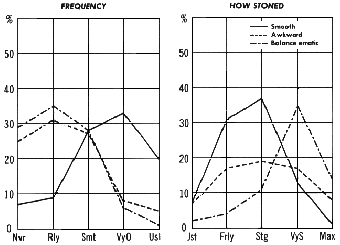 |
| Figure 11-4. QUALITY OF MOVEMENT Note.—For guide to interpreting the "How Stoned" graph, see note on Figure 6-1. |
The relationships between these three effects on the quality of movement are plotted in Figure 11-4. Movement seeming exceptionally well coordinated occurs significantly more frequently than movement being uncoordinated and jerky (p<<.0005) or than the sense of balance being lost (p <<<.0005). There is no significant difference in frequency of occurrence between awkwardness and erratic balance. Exceptional smoothness of movements occurs at lower levels of intoxication than awkwardness (p <.0005) and, in turn, awkwardness occurs at lower levels of intoxication than balance becoming lost (p < .0005). In general, marijuana intoxication seems at first to make movements feel smoother and more coordinated, but at very high levels of intoxication this may reverse and may sometimes culminate in experiential loss of the sense of balance.
PERCEPTION OF INTERNAL PROCESSES
Shape of the Body and Location of the Self
We shall first consider an infrequent effect that stands as a bridge between the perception of the ordinary body with modifications and a more radical shift toward new internal perceptions. "My perception of how my body is shaped gets strange; the felt' shape or form doesn't correspond to its actual form (e.g., you may feel lopsided, or parts of your body feel heavy while others feel light," a fairly frequent effect (29%, 29%, 32%, 6%, 2%), which may begin to occur at Very Strong levels of intoxication (1%, 9%, 15%, 24%, 13%). This is of particular interest also in its relation to identity; the constancy of our perceived body can lend a stability to our sense of identity. Indeed, many people will readily localize their own consciousness in some part of their body more than others, and this may also change during marijuana intoxication. "The location of my consciousness, the physical locale of the part of me that seems most me, has moved to different parts of my physical body from those it occupies while straight" is reported, albeit infrequently (55%, 17%, 18%, 3%, 2%) and at Strong levels of intoxication by those users who could rate it (1%, 5%, 12%, 13%, 6%). The College-educated need to be more intoxicated than the Professionals to experience this (p <.01).Note that the rather high incidence of out-of-the-body experiences in this sample, already discussed in Chapter 10, represents an even more radical change in the experienced location of consciousness with respect to the body.
Interior Perceptions
General awareness of internal organs and processes was investigated with "I become aware of parts of my body that I am normally unaware of can't become aware of when straight, such as internal organs." This is an infrequent effect (35%, 23%, 27%, 11%, 2%), which may begin to occur at Strong levels of intoxication (1%, 3%, 19%, 21%, 13%), and is higher for Males than Females (p <.05). The converse effect. "My body gets very numb, without feeling," however, occurs almost as frequently (42%, 29%, 22%, 5%, 1%) and at similar intoxication levels (0%, 3%, 16%, 19%, 17%). Males experience numbness slightly more often than Females (p <.05), but need to be more intoxicated to have the experience (p <.01).That both increased perception of internal organs and bodily numbness occur, with about equal frequency and at the same levels of intoxication, serves to underscore the importance of psychological and situational factors in determining which of many potential effects may manifest at any given time.
We shall now consider some particular types of awareness of internal organs and processes, starting with the most frequent.
Warmth
"I feel a lot of pleasant warmth inside my body" is a common effect (13%, 13%, 34%, 25%, 13%), which begins to occur at Moderate to Strong levels of intoxication (9%, 23%, 33%, 17%, 1%).Beating of the Heart
"I am much more aware of the beating of my heart" is also common (11%, 19%, 41%, 18%, 10%), more so with females (#p <.05). It may begin to occur at Strong levels of intoxication (5%, 22%, 34%, 19%, 6%), with the Professionals needing to be less intoxicated to experience this (p < 05).Breathing
"I become very aware of my breathing and can feel the breath flowing in and out of my throat as well as filling my lungs" is also common (21%, 18%, 40%, 15%, 5%), more so with the College-educated (p <.05). It may begin to occur at Strong levels of intoxication (6%, 13%, 33%, 18%, 6%). Meditators may experience this at lower levels of intoxication than the Therapy and Growth group or ordinary users (p <.01, overall), probably because so many techniques of meditation involve becoming more aware of the flow of breath.Defecating and Urinating
"When defecating or urinating, I become aware of the internal organ processes involved that I can't be aware of when straight." This is an infrequent effect (43%, 16%, 21%, 13%, 5%), which is reported more frequently by Heavy Total users (p <.05, overall). It is also experienced more frequently by the Therapy and Growth group (p <.05, overall). It may begin to occur at Strong and higher levels in those who experience it (1%, 7%, 19%, 17%, 5%).Sexual Orgasm
Note also that "Sexual orgasm has new qualities, pleasurable qualities, when stoned," is a characteristic effect. It is discussed fully in Chapter 13.Most of the above experiences have a known physiological basis. We now come to a group of experiences which cannot be readily conceptualized as resulting from increased awareness of known physiological processes.
Vibration, Energy, Chakra Centers
The most common of these is "I get feelings in my body that are best described as energy, force, power of some sort flowing" (21%, 13%, 35%, 21%, 9%). Both the Meditators and the Therapy and Growth group experience this somewhat more often than Ordinary Users (p <.05, overall). It may begin to occur at Strong and higher levels of intoxication (4%, 10%, 25%, 26%, 7%). This experience is reported more frequently by Users of Psychedelics (p <.05).A more general phenomenon that does not specifically interpret unusual internal feelings as energy or force is "I feel a vibration or tingling sensation in some or all of my body that I can tell is not an actual muscle tremor by looking at my body," a common effect (27%, 15%, 32%, 17%, 7%). It is reported about as frequently, and at similar levels of intoxication (1%, 10%, 24%, 25%, 7%), as sensations of force or energy. It is also of interest to note that these tingling feelings are reported more frequently than actual muscle tremors (p <.0005).
There is an occult theory, known mainly in its Indian form in the West (Garrison, 1964) but occurring in the occult traditions of many lands (Blofeld, 1970; Chang, 1963; Evans-Wentz, 1958; Frager, 1970; Govinda, 1960; Muses, 1961), that there is some sort of psychical energy that flows through man's body, and particularly through the nerves such as those in the spinal cord. This energy has been called a variety of names, such as prana in India, ki in Japan (Westbrook & Ratti, 1970), magnetic fluid (Mesmer, 1774), and odic force (von Reichenbach, 1968). While proof of the physical reality of such a force is highly debatable, it is clearly a phenomenological reality. Since experiences with some sort of energy were mentioned by informants in designing the present study, the two previous questions were included to deal with this phenomenon. The phenomenon of an aura around people (Chapter 6) is also considered a manifestation of this energy in some occult systems.
Two more specific questions deal with the common statement in occult philosophies that the spinal cord is the main channel for this energy to flow through and that there are special centers (chakras in Yoga literature, latifa in Sufi literature; see Shah, 1968) in the body, primarily lying along the spinal cord, in which this energy may activate special sorts of experiences; i.e., if the energy flows into one of these centers, special psychological and/or spiritual experiences are manifested. An example will be given below.
"I become very aware of my spine and feel energy f owing through it" is a rare effect (59%, 17%, 14%, 2%, 3%), which may occur at Very Strong and Maximal levels of intoxication (3%, 4%, 7%, 14%, 7%). It is reported more frequently by Meditators (p <.05, overall) and by Users of Psychedelics (p < .05).
"I become aware of chakra centers along my spine and feel changes in my state of consciousness as energy flows through the chakras" is also a rare effect[1] (65%, 14%, 6%, 3%, 1%), which may occur at Very Strong and Maximal levels of intoxication (2%, 2%, 2%, 8%, 8%) in the few who have experienced it. It occurs more frequently among Heavy Total users (p <.05, overall) and among Meditators (#p <.01, overall).
One of my informants, asked to describe an experience with chakra centers in detail, replied:
I occasionally try various Yoga breathing and meditation exercises when I'm stoned. Several times I've tried one of inhaling slowly and deeply, picturing a flow of energy coming in with my breath and going right on down to the base of my spine. I hold my breath for half a minute to a minute, all the time picturing an accumulation of energy in the root chakra at the base of the spine. As I slowly exhale I picture this energy as flowing up my spine, all the way up to my brain. The several times I've done this have convinced me that prana is real and powerful enough so I've decided to stop fooling around with it. The first few breaths I'm picturing, imagining all this, but then it becomes real and I can feel the energy, the prana, flowing up my spine. My consciousness is changed in distinct jumps as it goes up my spine; and by the time the prana flows into my head, there is a very distinct jump, and I'm suddenly more stoned, and 25 percent more stoned than I usually am for smoking whatever quantity of grass I've had. I'll stay more stoned as long as I keep up the exercise, but drift back down in a minute or two after I stop. I can't really describe the nature of the particular sorts of consciousness I experience as the energy jumps up along the spinal cord....
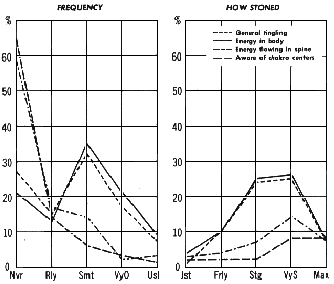 |
| Figure 11-5. PERCEPTION OF PSYCHICAL ENERGY Note.—For guide to interpreting the "How Stoned" graph, see note on Figure 6-1. |
Figure 11-5 summarizes the relationships between the four questions dealing with perception of non-physical energies. Awareness of a general tingling or vibration, or feelings of energy or force in the body, both occur commonly; awareness of energy flowing in the spine or of chakra centers occurs much less frequently (p <<<.0005, overall). Both of the latter two phenomena also occur at significantly higher levels of intoxication than the former two (p <.05, overall).
Nausea and Sickness
Two rare phenomena complete the items dealing with the body. "I get dizzy or nauseated, so much so that I wonder if I will get sick" occurs rarely or not at all for the vast majority of users (47%, 41%, 8%, 1%, 1%). Actual sickness, "I have gotten very nauseous and vomited" is significantly (p <.0005) rarer (80%, 15%, 2%, 0%, 1%). Of the users who could rate these effects, these were generally considered the very highest-level phenomena (1%, 1%, 6%, 13%, 21% and 1%, 0%, 1%, 5%, 8%, respectively). My informants indicate that the usual way feelings of nausea are dealt with is to lie down, divert one's attention, and wait for them to pass. Usually one or two experiences with nausea are sufficient to teach a user what his overdose level is, and he will avoid smoking enough marijuana to reach that level in the future.[2]ADDITIONAL EFFECTS
Many additional effects were volunteered for the body:"When I'm walking it seems as if the world is rolling under me and I'm remaining still" (Very Often, Fairly).
"I become much more aware of my body temperature" (Usually, Fairly).
"Pains in the chest" (Sometimes, Fairly).
"I feel like I am controlling a huge machine (my body) from my eyes" (Sometimes, Very Strongly).
"After much pot, my head feels as if it were about to explode" (Sometimes, Very Strongly).
"My whole body is surrounded by a ghost body about six inches thick (all rounded); when I close my eyes, I fill out" (Sometimes, Very Strongly).
"I can feel the blood rushing through my veins, pulsating throughout my entire body" (Usually, Just).
"Body consciousness includes large amount of space all around actual physical body" (Usually, Fairly).
"Parts of my body begin to feel as if they're moving wildly, faster and faster, in geometrical patterns. Actions I perform are repeated over and over in my mind, so that I feel that my body is racing about (i.e., I chew my food and suddenly my mouth is moving in fast, set patterns), even though I'm doing this slowly or not at all" (Very Often, Very Strongly).
"My feet and legs immediately become cold and numb when stoned and become progressively number and colder as my 'stonedness' increases in magnitude. When exceptionally stoned, I sometimes feel no contact with my skin. I've received surface injuries and not felt them. Heat and cold are difficult to perceive. I've walked in snow barefoot and not felt cold" (Very Often, Strongly).
"I become keenly aware of unrelaxed muscles and sphincters" (Sometimes, Very Strongly).
LEVELS OF INTOXICATION FOR BODILY EXPERIENCES
The various phenomena are arranged by levels of intoxication in Figure 11-6. The overall ordering is highly significant (p <<<.0005).| Just | Fairly | Strongly | Very Strongly | Maximum | |||||
| |||||||||
| Vomit | |||||||||
| Float in space | |||||||||
| Feel nauseated | |||||||||
| LOSE ALL CSS OF BODY DURING FANTASY | |||||||||
| Aware of chakras | |||||||||
| BODY GETS NUMB | |||||||||
| FELT FORM DIFFERENT FROM ACTUAL BODY SHAPE | |||||||||
| Feel energy in spine | |||||||||
| MORE AWARE OF INTERNAL ORGANS GENERALLY | |||||||||
| MUSCLE TREMOR | |||||||||
| CHANGE IN LOCATION OF CONSCIOUSNESS | |||||||||
| VIBRATION IN BODY THAT IS NOT MUSCLE TREMOR | |||||||||
| AWARE INTERNAL ORGANS, URINATING | |||||||||
| BODY FEELS LARGER | |||||||||
| BODY FEELS SMALLER | |||||||||
| FEEL ENERGY, POWER FLOW IN BODY | |||||||||
| BODY PART ATTENDED TO STANDS OUT MORE | |||||||||
| SENSE OF BALANCE ERRATIC | |||||||||
| BODY SEEMS VERY LIGHT, FLOATING | |||||||||
| BODY SEEMS VERY HEAVY | |||||||||
| LOSE AWARENESS OF BODY UNLESS STIMULATED | |||||||||
| VERY AWARE OF BREATHING | |||||||||
| MOVEMENTS AWKWARD, UNCOORDINATED | |||||||||
| FEEL WEAKER | |||||||||
| AWARE OF HEART BEATING | |||||||||
| FEEL STRONGER | |||||||||
| LESS AWARE OF BODY TENSIONS IN EMOTION | |||||||||
| PAIN EASIER TO TOLERATE IF ATTENTION DIVERTED | |||||||||
| SEXUAL ORGASM HAS NEW, PLEASURABLE QUALITIES | |||||||||
| OBJECTS SEEM LIGHTER | |||||||||
| MORE AWARE OF BODY TENSIONS IN EMOTION | |||||||||
| SURFACES FEEL ROUGHER, FORM PATTERNS | |||||||||
| PLEASANT WARMTH THROUGHOUT BODY | |||||||||
| PAIN MORE INTENSE IF CONCENTRATED ON | |||||||||
| OBJECTS SEEM HEAVIER | |||||||||
| NEW QUALITIES TO TOUCH | |||||||||
| SURFACES SEEM SMOOTHER, SILKIER | |||||||||
| MOVEMENTS EXCEPTIONALLY SMOOTH | |||||||||
| GET PHYSICALLY RELAXED, DON'T WANT TO MOVE | |||||||||
| TOUCH MORE EXCITING | |||||||||
| GET PHYSICLLY RESTLESS | |||||||||
| Just | Fairly | Strongly | Very Strongly | Maximum | |||||
Effects on the perception of the user's body begin between the Fairly and Strongly intoxicated levels, and at first consist primarily of alterations in the perceived interaction of the body with external objects, i.e., the touch and muscle senses. As the user gets higher, sexual orgasm characteristically acquires new, pleasurable qualities, and a variety of internal processes may become accessible to awareness if attention is turned there. From this level up, the experienced body becomes more and more affected by the direction of attention rather than by the inherent physical structure of the body.
Between the Strong and Very Strong levels of intoxication, very unusual sorts of perceptions may begin to occur, which become more pronounced at higher levels, namely, sensations of vibration and energy inside the body, as well as the increased possible awareness of internal organs. The size and shape of the user's body may seem to change and the location of his consciousness in his body alter. Between Very Strongly and Maximally intoxicated, he may lose all awareness of his body during fantasy, and a few users may become aware of the chakra centers along the spine. At the maximal levels the user may feel nauseated, although this is rare, and even more rarely may actually vomit as a result of this nausea.
MODULATING FACTORS
Background factors affecting perception of the body, which had relatively linear effects, are summarized in Table 11-1. Both more drug experience and experience with meditation are associated with more frequent experience of energy in the body and some of its exotic concomitants such as chakra centers.Feeling physically relaxed and not wanting to move is mostly reported at Fairly/Strongly as a minimal level of intoxication, but Weekly users have a significant number of responses at Very Strong/Maximum for this. The same pattern occurs for Weekly users on levels of intoxication for movement being exceptionally smooth.
| BACKGROUND FACTORS | EFFECTS | |
|---|---|---|
| More Drug Experience | More frequent: Body feels smaller Feel stronger Aware of internal organs when defecating Feel energy in spine Aware of chakra centers Movements awkward Feelings of energy in body | Less frequent: Lose awareness of body parts not focused Pain more intense Movement exceptionally smooth, coordinated Lose consciousness of body in fantsy Less intoxicated for: Pain more intense |
| Older | More intoxicated for: Pain more intense | Less frequent: Pain more intense Body feels heavier Physically restless Less intoxicated for: Float in limitless space Lose awareness of body parts not focused on Balance erratic |
| More Educated | More intoxicated for: Movements awkward | Less frequent: Pain more intense Body feels light Body feels smaller Hyperaware of breathing Physically restless Less intoxicated for: Location of consciousness moves Aware of heart beating |
| Males | More frequent: Body feels numb More intoxicated for: More aware of internal organs Body feels numb Body feels smaller | Less frequent: Aware of heart beating Movements exceptionally smooth, coordinated Balance erratic |
| Meditators | More frequent: Energy in body Energy in spine Aware of chakra centers | Less intoxicated for: Hyperaware of breathing |
| Therapy & Growth | More frequent: Aware of internal organs when defecating Energy in body | |
SUMMARY
Except for various enhancements of touch sensation, physical relaxation, and smoothness of movement, there are practically no characteristic effects of marijuana intoxication on the perception of the user's body, i.e., while there are many potential alterations of the perception of the body, few of them are highly likely unless specific psychological and situational factors bring them out.In general, the perception of the body becomes less determined by actual structure and more affected by the deployment of attention during marijuana intoxication. The body and its parts may fade partially or completely from awareness if not concentrated on, and the user may totally lose awareness of his body and be immersed in some internal experience or fantasy. When attention is deployed properly (voluntarily or by circumstances), a wide variety of perceptions of the internal workings of the body are possible, including many processes which one cannot normally be aware of. It is also common for various feelings described as energy, force, or power to be sensed within the body.
The only bodily effect of marijuana intoxication that is decidedly unpleasant, nausea, is a rare effect, usually coped with by the user's diverting his attention; actual sickness is extremely rare.
These experimental alterations of bodily perception could be of great theoretical importance to psychosomatic medicine and the study of the relationship of identity to the body.
Footnotes
1. It is interesting to note that most users (89 percent) apparently knew what chakras were, for few skipped this question completely as they had been instructed to do if a question made no sense to them. This reflects the tremendous rise of interest in metaphysics and the occult among the young.2. In many of the laboratory studies of marijuana or one of its active ingredients, tetrahydrocannabinol (THC), nausea is frequently reported by subjects, suggesting that the experimenters may be overdosing them. While such findings are of interest in a purely scientific sense, they are not representative of the ordinary use of marijuana.
Chapter 12. Social Interaction
MUCH MARIJUANA use is carried out in the company of other users. This results not only in a variety of effects on interpersonal relations, but the gestalt configuration of a group of users at any given time can strongly affect each user's individual experiences.
We shall consider social effects under three semi-distinct categories: (1) overall characteristics of groups of intoxicated users; (2) perceptions of the quality of social interaction; and (3) some negative effects on social interaction.
OVERALL CHARACTERISTICS OF INTOXICATED GROUPS
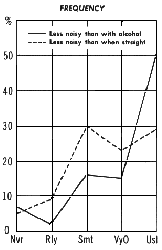 |
| Figure 12-1. NOISINESS AT PARTIES |
Quieting Effects
An extremely characteristic effect of marijuana intoxication, in comparison to alcohol intoxication, is "I am less noisy and boisterous at parties than when drunk or tipsy on alcohol" (7%, 2%, 16%, 15%, 51%). One informant remarked, "When the cops walk into a party and everybody is yelling, arguing, and reeling around, they don't bother you; but if everybody is sitting around quietly talking or listening to music, they hassle you because they're pretty sure you're stoned!" Moderate Total use is associated with a higher frequency of this than Light, and Light with a higher frequency than Heavy (p <.05, overall). Quietness begins to occur at Low levels of intoxication (23%, 27%, 20%, 9%, 1%).This sort of quietness is characteristic even without a comparison with alcohol intoxication: "I am less noisy and boisterous at parties than when straight" (5%, 9%, 30%, 23%, 29%). This is reported less frequently by the Occasional users (p <.05, overall). Users of Psychedelics do not need to be as intoxicated to experience this (p <.05), and the effect generally begins at Moderate levels (16%, 30%, 29%, 11%, 3%).
Being less noisy than when intoxicated on alcohol is more frequent (p <.0005) than being quieter than when straight, as shown in Figure 12-1, but they occur at essentially the same levels of intoxication.
 |
| Figure 12-2. AMOUNT OF TALKING WHEN INTOXICATED Note.—For guide to interpreting the "How Stoned" graph, see note on Figure 6-1. |
The Meditators less often report that they talk more when intoxicated (p <.05, overall). The College-educated need to be more intoxicated to talk more (p <.05), as do Users of Psychedelics (p <.01).
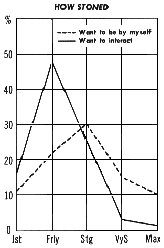 |
| Figure 12-3. SOCIABILITY |
Sociability
"I become more sociable: I want to be with and interact with people more" is a common effect (5%, 17%, 45%, 19%, 12%), but its converse, "I become less sociable; I want to be by myself" is just as common (7%, 19%, 49%, 17%, 7%). The latter effect occurs at higher levels of intoxication than the former (16%, 48%, 25%, 3%, 1% and 11%, 22%, 30%, 15%, 10%, respectively, p <.0005), as shown in Figure 12-3. Of the people at a marijuana party, the ones sitting by themselves may often be more intoxicated than the ones conversing. The Meditators report higher levels of intoxication for wanting to be by themselves (p <.05, overall).Changes in Overt Behavior
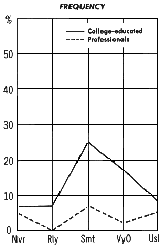 |
| Figure 12-4 EDUCATIONAL LEVEL AND UNNOTICEABILITY OF INTOXICATION |
The users were asked to rate the highest level of intoxication at which others have not noticed they were intoxicated. This was primarily the Strong and Very Strong levels (5%, 15%, 27%, 23%, 5%); thus, users can be experiencing a wide variety of powerful effects without outside observers (friends who were straight at the time) being able to notice any differences in their external behavior. Heavy Total users indicate higher levels for this unnoticeability (Very Strong/Maximum) than Moderate and Light Total users (p < .05, overall), as do Users of Psychedelics (p <.05). More drug experience apparently allows the user to appear normal at very high levels of intoxication.
The converse of unaltered external behavior is "Others (who were straight at the time) have told me that I act very differently when I'm stoned,"an infrequent effect (39%, 23%, 21%, 9%, 3%), which may begin to occur at Very Strong levels of intoxication (2%, 5%, 12%, 19%, 11%). As shown in Figure 12-5, acting noticeably different when intoxicated occurs less frequently than no noticeable differences (p <<.0005), and at higher levels (p <.01).
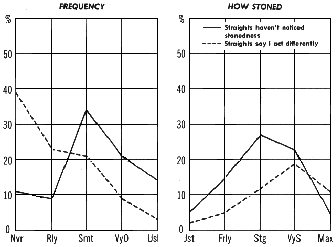 |
| Figure 12-5 EXTERNAL BEHAVIOR INDICATIVE OF BEING INTOXICATED Note.—For guide to interpreting the "How Stoned" graph, see note on Figure 6-1. |
Given these general qualities of marijuana intoxication on social groupings, namely, a general quieting effect, let us now examine what changes in social interaction are reported when the user chooses to interact with others.
QUALITY OF SOCIAL INTERACTION
Game Playing
A very characteristic effect of marijuana intoxication is "I find it very hard to play ordinary social games when stoned"(6%, 7%, 21%, 35%, 27%), i.e., various kinds of polite social chit-chat and the like seem hollow and worthless, not worth engaging in. They are "seen through," as later descriptions of effects will indicate. This is reported less frequently by Heavy Total users (p <.0005, overall), suggesting some Heavy Total users have learned to function quite easily in ordinary social settings. The College-educated also experience this difficulty more frequently (p <.05). This effect begins to occur by Moderate levels (13%, 32%, 24% 13%, 5%)On the other hand, it is common for users to report "I can play elaborate games and get very involved in the games" (14%, 25%, 34%, 17%, 9%), beginning at Moderate to Strong levels (13%, 31%, 30%, 8% 1%). Light Total users have to be more intoxicated for this (p <.05) and Users of Psychedelics less intoxicated (p <.05). The social games played while intoxicated are not always elaborate, however; "when stoned with others, I play 'childish' games; i.e., we interact with each other in ways which are very enjoyable but which people would ordinarily consider childish" is a very common experience (5%, 15%, 51%, 22%, 7%). As one informant put it, "Kids have a lot of fun just doing groovy things like skipping; and if you're stoned with your friends and somebody says 'Wouldn't it be neat to skip down the road?' we may do it and have a ball. We care less that some dumb-ass old authority figure is sitting around and frowning and saying, 'Grownups don't skip!' " Playing childish games may occur in the Moderate to Strong levels and higher (9% 31%, 37%, 15%, 1%).
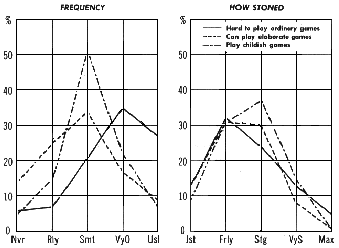 |
| Figure 12-6. SOCIAL GAME PLAYING Note.—For guide to interpreting the "How Stoned" graph, see note on Figure 6-1. |
Figure 12-6 plots the interrelationships of these three aspects of social game playing. Difficulty in playing ordinary games is more frequent than playing childish games (p <.0005), and playing childish games is more frequent than playing elaborate games (p <.01). Playing childish games tends to occur at higher levels than finding it hard to play ordinary social games (p <.05), but there are no other significant differences in level of intoxication.
There are a number of alterations in the perception of social interaction that lie behind the change in overall social interaction, which we shall now consider in decreasing order of frequency.
Insights into Others
A characteristic effect is "I have feelings of deep insights into other people, how they tick, what their games are, when stoned (regardless of whether they check out later)" (7%, 7%, 31%, 34%, 21%). These feelings occur in the Moderate to Strong levels (10%, 35%, 39%, 6%, 2%). A related phenomenon, discussed fully in Chapter 6, is "The face of another person will change even as I watch it, so he keeps changing from one different person to another." Some informants indicate that sometimes this is a purely illusory experience on the part of the perceiver but other times it seems a veridical "illusion" in that it allows insights into the perceived person's character, literally seeing one of the other "persons" within him. Another common, related phenomenon, discussed fully in Chapter 15, is "I learn a great deal about psychological processes, what makes people tick...."Not only do users characteristically feel as if they have insights into others, they very commonly empathize with them: "I empathize tremendously with others; I feel what they feel; I have a tremendous intuitive understanding of what they're feeling" (7%, 11%, 40%, 25%, 18%). This begins to occur at Moderate to Strong levels of intoxication (12%, 31%, 35%, 10%, 1%). A more extreme form of this, discussed in Chapter 10, is the infrequent feeling of telepathic rapport with others. Indeed, this can reach the point of feeling merged with another person, or being at one with the world, as discussed in Chapter 18.
Profundity
Another very common effect influencing social interaction is "I feel the things I say in conversation when stoned are more profound, more appropriate to the conversation, more interesting" (5%, 13%, 37%, 27%, 15%). This occurs at Moderate to Strong levels (9%, 38%, 31%, 11%, 1%). While most Users of Psychedelics indicate this happens at Fair and Strong levels, Non-users are more variable, indicating Fairly and Very Strongly as main levels (p < .05).Subtlety and Humor
A related characteristic effect is "I appreciate very subtle humor in what my companions say, and say quite subtly funny things myself," dealt with in Chapter 15. Similarly, the common effect "I giggle a lot when stoned..." is dealt with fully in Chapter 16.Another related phenomenon, dealt with in Chapter 15, is "Commonplace sayings or conversations seem to have new meanings, more significance."
Group Unity
Our group of marijuana users, then, may be sitting together feeling as if they have increased insight into one another, empathizing more fully with one another, being more childlike and open, and saying more profound things. Thus it is not surprising to find that a very common effect of marijuana intoxication is "When stoned with a group of people, the group takes on a much greater sense of unity, of real social relationship, than when straight; i.e., I feel much more part of a group instead of one person simply in the presence of other people" (7%, 17%, 30%, 25%, 21%). As with the other social effects, this begins to occur at Moderate to Strong levels of intoxication (15%, 35%, 29%, 10%, 0%).[2]Contact Highs
There is one particularly interesting social effect occurring in groups of users, which further illustrates the importance of psychological variables in affecting the nature of the intoxicated state: "Being with people who are much higher than I am (as from their being on acid or much more stoned on grass) gets me higher even though I don't smoke any more grass." This is a common effect (13%, 13%, 32%, 23%, 15%), which may occur even at the lowest levels of intoxication (23%, 22%, 26%, 5%, 2%).Related Phenomena
Other relevant phenomena for understanding social interaction are the loss of short-term memory, the feeling that this does not seriously impair the user's ability to carry on an intelligent conversation, and the feeling of having said things that were not actually said (discussed in Chapter 14), as well as various alterations in other cognitive phenomena (discussed in Chapter 15).NEGATIVE EFFECTS ON SOCIAL INTERACTION
There were four effects studied that seem predominantly negative. The first of these is "I feel isolated from things around me, as if there were some kind of barrier or glass wall between me and the world, muting everything coming in and partially isolating me," a common effect (29%, 21%, 33%, 14%, 3%). The Meditators experience this less often (p <.01, overall). It may occur at the Strong and Very Strong levels (4%, 11%, 22%, 21%, 9%).Another infrequent effect is "I get somewhat paranoid about the people with me; I am suspicious about what they're doing" (20%, 38%, 31%, 7%, 4%). Non-users of Psychedelics experience it more frequently (p <.01). This also may occur at the Strong and Very Strong levels (9%, 15%, 21%, 24%, 7%). The Meditators tend to experience paranoid feelings at lower levels of intoxication (p <.05, overall).
What may be an even more extreme cutting-off from social relationships is the rare phenomenon, "Other people seem dead, lifeless, as if they were robots, when I'm stoned"(49%, 27%, 18%, 5%, 0%). This effect may begin occurring from the moderately intoxicated level on up in the users who could rate it (3%, 11%, 13%, 14%, 6%). Users of Psychedelics may experience it at lower levels (p <.05).
An infrequent negative effect of the group on the user is "I am very strongly influenced by the social situation set up by my companions, so I will do whatever they are doing, even if it is something I don't want to do or wouldn't do normally" (33%, 38%, 23%, 3%, 0%). This is reported as occurring more frequently by Males (p <.05). Weekly users also have it occur more frequently than Occasional or Daily users (p < .05). In retrospect, this question is hard to interpret, as it does not specify how undesirable the actions are that a group might pressure the user into doing. A highly relevant question, dealt with fully in Chapter 17, is "I lose control of my actions and do antisocial things (actions that harm other people) that I wouldn't normally do." This is one of the rarest phenomena reported, with 77 percent saying Never, 22 percent Rarely, and only one user saying Sometimes. Thus the question on social influence must deal primarily with actions ordinarily unacceptable to the individual, but not necessarily harmful.
ADDITIONAL EFFECTS
Four users mentioned increased feelings of love and compassion toward others: (1) "Increased feelings of tenderness and compassion toward people I'm with, and toward animals, if any present" (Very Often, Strongly); (2) "I become less evaluative of myself and others, more loving" (Usually, Fairly); (3) "I am more concerned with other people's happiness" (Very Often, Fairly); and (4) "If there is some particular person whom I have not cared for, if I get the opportunity to be around him while I'm stoned, I often gain understanding of him and feel very close to him afterwards. The person need not also be stoned" (Very Often, Strongly)."Feel that many statements made by other people are, more often than not, ambiguous" (Very Often, Strongly).
"When I am with others we tend to share fantasies" (Very Often, Strongly).
"I am more tolerant of other people's beliefs and ideas" (Usually, Fairly).
"I tend to become a member of a group: laugh when they laugh, listen when they listen" (Sometimes, Strongly).
"People seem more violent when I am stoned" (Sometimes, Maximum).
"I enjoy listening to stories about people" (Usually, Strongly).
"I feel much more political" (Very Often, Just).
"A feeling that my friends are different when they're stoned" (Usually, Just).
"Think you would like to turn others on" (Rarely, Maximum).
"Say something and then realize no one heard you—this is frightening, for you're with people and they didn't notice you at all" (Sometimes, Very Strongly).
"I dislike people, especially men who are with me—I see them differently, more clearly, it seems" (Very Often, Fairly).
"An ability to communicate ritual messages" (Usually, Strongly).
"I am aware of multi-level communication; i.e., people are communicating more things than their words express, and often the messages
aren't related, or one is used to communicate another" (Very Often, Strongly).
"A good way to get to know someone more quickly" (Very Often, Fairly).
"I tend to want to be with familiar people who are as stoned as I" (Usually, Maximum).
"Can relate better to my own children" (Very Often, Fairly).
"Strong desire to be alone, bordering on narcissism" (Very Often, Strongly).
"Experience extreme withdrawal" (Sometimes, Just).
"Loneliness has a pleasant rather than an undesirable quality" (Usually, Just).
LEVELS OF INTOXICATION FOR SOCIAL INTERACTION
The effects of marijuana intoxication on social interaction by level of intoxication are summarized in Figure 12-7. The overall ordering of levels is highly significant (p <<< .0005).| ——Others do not notice I'm stoned—— | ——Others notice I'm stoned—— | ||||||||
| Just | Fairly | Strongly | Very Strongly | Maximum | |||||
| |||||||||
| MERGE, BECOME ONE WITH OTHERS | |||||||||
| PEOPLE'S FACS CHANGE | |||||||||
| OTHERS NOTICE I'M STONED | |||||||||
| Do antisocial things | |||||||||
| FORGET START OF SENTENCE | |||||||||
| AT ONE WITH THE WOPRLD | |||||||||
| THINK I'VE SAID SOMETHNG WHEN I'VE JUST THOUGHT IT | |||||||||
| FEEL ISOLATED | |||||||||
| CONVERSE INTELLIGENTLY EVEN THOUGH THINGS ARE FORGOTTEN | |||||||||
| FORGET START OF CONVERSATION | |||||||||
| FEEL PARANOID | |||||||||
| OTHERS STILL DO NOT NOTICE I'M STONED | |||||||||
| TELEPATHY | |||||||||
| People seem dead, like robots | |||||||||
| GIGGLE A LOT | |||||||||
| LEARN A LOT ABOUT WHAT MAKES PEOPLE TICK | |||||||||
| SIGNIFICANCE IN COMMONPLACE CONVERSATIONS | |||||||||
| LESS SOCIABLE | |||||||||
| TALK LESS | |||||||||
| PLAY CHILDISH GAMES | |||||||||
| STRONGLY INFLUENCED BY COMPANIONS | |||||||||
| EMPATHIZE MORE WITH OTHERS | |||||||||
| INSIGHTS INTO OTHERS | |||||||||
| SAY MORE PROFOUND, APPROPRIATE THINGS | |||||||||
| MORE SUBTLE HUMOR | |||||||||
| PLAY ELABORATE GAMES | |||||||||
| MORE GROUP FEELING | |||||||||
| ORDINARY SOCIAL GAMES HARD TO PLAY | |||||||||
| LESS NOISY THAN WHEN STRAIGHT | |||||||||
| TALK MORE | |||||||||
| MORE SOCIABLE | |||||||||
| HIGHER PEOPLE GET ME HIGHER | |||||||||
| LESS NOISY THAN WHEN DRUNK | |||||||||
| Just | Fairly | Strongly | Very Strongly | Maximum | |||||
| ——Others do not notice I'm stoned—— | ——Others notice I'm stoned—— | ||||||||
Beginning at Low to Moderate levels, there is a general reduction of loudness and noisiness as the pattern of social interaction begins to change from ordinary interaction to that characteristic of groups of intoxicated users. Ordinary social games become harder to play; users become more sociable and talk more. Thought processes begin to alter so the users feel they have insights into others and interact more subtly, especially with respect to humor. A strong feeling of group solidarity commonly occurs in this Moderate to Strong range of intoxication. Generally, at these low levels, users feel social interaction is greatly enhanced.
As the users begin to enter the Strong ranges and higher, however, inner experience often begins to predominate over social interaction. When social interaction continues, it is usually felt to be very profound. At the highest ranges it includes occasional feelings of telepathic contact and merging with others. Because of the increasing intensity of inner experiences, however, from the Strong level up, many users become less sociable, more wrapped up in themselves. Many of my informants comment that when marijuana is first smoked at a social gathering, there is a lot of interaction, conversing, group discussion, good feeling, but if a lot is smoked, a fair number of people will often begin to withdraw into themselves or become involved in intense dialogues with another user rather than take part in the general group interaction.
Thus low levels of intoxication seem to facilitate and deepen social interaction among users, whereas higher levels may either deepen it further or result in withdrawal from the group.
MODULATING FACTORS
Table 12-1 summarizes the effects of relatively linear background factors on social interaction effects.Two phenomena were not affected linearly by frequency of use. Weekly users more frequently report being strongly influenced by their companions. They also need to be more intoxicated to believe they've said something when they haven't.
| BACKGROUND FACTORS | EFFECTS | |
|---|---|---|
| More Drug Experience | More frequent: People's faces change Less noisy than when straight Telepathy More subtle humor More intoxicated for: Talk more People haven't noticed I'm stoned Giggle a lot Forget start of conversation | Less frequent: Think said something when just thought it Feel paranoid Hard to play ordinary social games Less intoxicated for: Quieter than when straight Insights into others People seem like robots Say more profound things Play elaborate games Telepathy |
| Meditation | More frequent: People's faces change Merge with others Feel one with world More intoxicated for: Less sociable | Less frequent: Talk more Feel isolated Less intoxicated for: Feel paranoid |
| More Educated | Less frequent: Ordinary games hard to play Less intoxicated for: Talk more Merge with others | |
| Older | More frequent: People haven't noticed I'm stoned | Less intoxicated for: Talk more Merge with others |
| Males | More frequent: Strongly influenced by companions More intoxicated for: Forget start of sentence | Less frequent: Giggle a lot |
SUMMARY
In terms of its effects on users' perceptions, marijuana acts as a potentiator of social interaction in the Low to Moderate intoxication levels. Users feel more empathy toward and insights into others, play childish and elaborate games, feel that their conversation is often profound, and commonly experience strong feelings of group unity.At high levels of intoxication, marijuana may have two different effects on users because of the intensification of inner experiences. The user may become less sociable and withdraw from a group in order to more fully appreciate the inner experiences he is having or, if he continues to interact, may feel that the interaction becomes exceptionally profound, including such things as merging with another person or feeling so aware of another that it seems like telepathic communication.
Negative effects on social interaction are mostly infrequent or rare.
Footnotes
1. This apparent rarity of changes in external behavior should be carefully noted in terms of research methodology; insofar as it is true, behavioristic approaches to this area will waste a lot of time.2. Note, however, that marijuana intoxication does not inevitably create group feelings; if some group members do not fit in or seem "phony," this will kill any feelings of closeness or group coherence.
Chapter 13. Sexuality
GIVEN THE COMMON American stereotype of the "sex-crazed dope fiend," it is interesting to see what effects on sexuality are perceived by marijuana users themselves.
MAJOR EFFECTS
Desire for Sex
A common effect is "My sexual drive goes up when stoned; I have more need for sex" (18%, 21%, 28%, 21%, 12%). This may begin to occur at the Moderate to Strong levels of intoxication (11%, 25%, 32%, 8%, 2%). Users of Psychedelics experience this at lower levels of intoxication (p <.0005), as does the Therapy and Growth group (p <.05, overall).The converse effect "I have much less sexual drive when stoned; it's difficult to arouse me even in a situation which would normally arouse me" is rare (42%, 34%, 15%, 5%, 2%). When it occurs, it is at the strong levels and higher (6%, 11%, 17%, 13%, 7%). The Professionals experience this loss of sexual need at lower levels of intoxication (p <.05).
A very common effect is "I have no increase in sexual feelings unless it's a situation that I would normally be sexually aroused in, and then the sexual feelings are much stronger and more enjoyable" (7%, 11%, 27%, 23%, 24%). Users of Psychedelics report this more frequently (p <.05) than Non-users. It generally occurs at Moderate to Strong levels (17%, 28%, 27%, 8%, 2%).
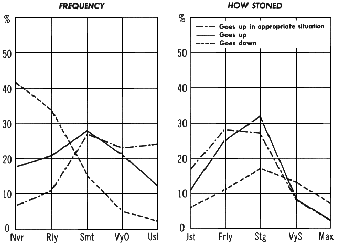 |
| Figure 13-1. DESIRE FOR SEXUAL INTERCOURSE Note.—For guide to interpreting the "How Stoned" graph, see note on Figure 6-1. |
The relationships of these three alterations of sexual need are plotted in Figure 13-1. Sexual need going up when the situation is appropriate is reported more frequently than need per se going up (p <.01), and sexual need per se going up is more frequent than its going down (p <<.0005). Most of my informants commented that sexual drive or need does not go up, but rather the knowledge of how intensely gratifying sex is when intoxicated serves to make any perceived sexual drive more attention getting and desirable when intoxicated.
With respect to levels of intoxication, they are the same for sexual desire per se going up and for sexual desire going up when the situation Is appropriate, but sexual desire going down occurs at higher levels of intoxication (p <.01 with respect to desire per se, p <.0005 with respect to desire in appropriate situations). My informants indicate that sexual intercourse at very high levels of intoxication can be an ecstatic, overwhelming experience, but at these levels chances are good that the user will be absorbed in his own inner experiences and not get interested in making love with someone.
Contact with Partner
A very common experience is "When making love, If eel I'm in much closer mental contact with my partner; it is much more a union of souls as well as bodies" (9%, 9%, 31%, 20%, 25%). This closeness occurs more frequently among Users of Psychedelics (p <.0005) and the College-educated (p <.05). It generally begins to be experienced at the Moderate and Strong levels (7%, 27%, 35%, 9%, 3%). The Heavy Total users and the Daily users both experience this closeness at lower levels of intoxication (p <.05 in each case).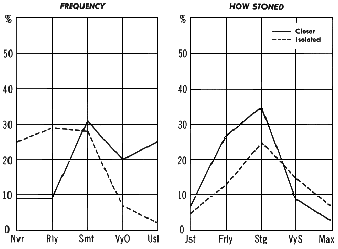 |
| Figure 13-2. MENTAL CONTACT WHILE MAKING LOVE Note.—For guide to interpreting the "How Stoned" graph, see note on Figure 6-1. |
The converse effect, "When making love, I feel rather isolated from my partner; I'm wrapped up in my intensified sensations and not really very aware of my partner's reactions and feelings" occurs infrequently (25%, 29%, 28%, 7%, 2%) and at Strong levels (5%, 13%, 25%, 15%, 7%). Feeling isolated from one's sexual partner occurs much less frequently than feeling closer (p << .0005) and at higher levels of intoxication (p <.05), as shown in Figure 13-2.
Qualities of Orgasm
One of the factors that enhance love-making when intoxicated on marijuana is the characteristic effect, "Sexual orgasm has new qualities, pleasurable qualities, when stoned" (6%, 9%, 22%, 27%, 28%). This occurs somewhat less often, albeit still very frequently, for the Meditators (p <.01, overall) and the Professionals (p <.01). Most users experience these new qualities of orgasm by the Strong level of intoxication (8%, 21%, 37%, 8%, 8%).Among the various qualities potentially going into orgasm enhancement that my informants are able to describe, one or several of the following may be experienced as part of an orgasm when intoxicated: (I) prolongation of orgasm (possibly an effect of time slowing); (2) feelings of energy flowing and/or exploding or erupting in the body; (3) feelings of energy interchange with one's sexual partner, both flows before orgasm and explosive interchanges through the genitals and whole body during orgasm; (4) absolutely total immersion in the orgasm, no distractions of any sort; (5) the orgasm taking place as ecstatic sensations through most of the body rather than being confined to the genital area; (6) merging of identity with one's sexual partner during orgasm, with a sharing of sensation and joy; (7) feelings that the energy interchange during orgasm balances and replenishes each partner's own vital energies, rather than depleting them—more so than when not intoxicated; (8) greater awareness of the bodily feelings leading up to orgasm, with a consequent ability to time one's movements in a way that will maximize the pleasurable qualities of the orgasm; (9) the ego temporarily disappearing, the body taking over, the orgasm happening rather than being produced; and (10) the feeling that the orgasm (and shared feelings with the sexual partner) are happening on a much vaster, wider scale than those consciously experienced, that this is an event of much greater magnitude or significance than the ego is able to sense or comprehend.
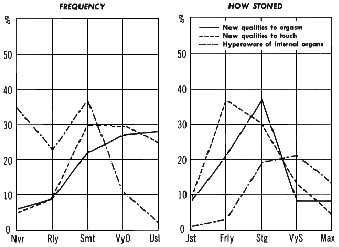 |
| Figure 13-3. ORGASM AND RELATED SENSATIONS Note.—For guide to interpreting the "How Stoned" graph, see note on Figure 6-1. |
Because a number of informants indicated they are aware of what seems to be organ sensations in genitals and gut that are normally not in awareness, it is interesting to compare this report of new qualities to sexual orgasm with two more general changes in sensation, namely, touch sensations taking on new qualities (Chapter 8) and becoming aware of internal organs and processes that are normally not accessible to consciousness (Chapter 11). The relationships are plotted in Figure 13-3. New qualities of orgasm do not occur more frequently than new touch qualities, but they do occur much more frequently than awareness of normally unsensed internal organs (p <<.0005). New touch qualities begin to occur at lower levels of intoxication than orgasm enhancement (p <.05), and increased awareness of internal organs at higher levels than orgasm enhancement (p <.0005). Apparently the sheer intensity of sexual orgasm may result in internal organ sensations connected with it that ordinarily occur at higher levels of intoxication.
Related Effects
There are a number of related intoxication phenomena, dealt with in preceding and subsequent chapters, that indicate, in conjunction with pilot interview data and comments of informants, some other specific ways in which sexual contact and intercourse can be altered. These will be briefly listed below."... sensual quality to vision..." (Chapter 6). Looking at one's lover can be like touching him or her.
"... face of another... will change even as I watch it..." (Chapter 6). One woman can become another woman, many women, all women, Woman.
"Touch sensations take on new qualities..."; ". .. touch more exciting, more sensual..."; "... surfaces feel smoother, silkier..."; and ". .. surfaces rougher... graininess forms interesting patterns ..." (Chapter 8). All of these changes in touch quality apply particularly to a lover's garments, skin, hair, mouth, genitals.
"Taste... new qualities..." and "Smell ... new qualities..." (Chapter 8) apply to kissing and oral-genital contacts.
"I empathize tremendously... feel what they feel. .." (Chapter 12). Your lover's joy is your joy; your lover's pain is your pain.
"... so absorbed... in a person... felt as if I were that... person..." (Chapter 18). Total blending, merging with one's lover.
"Some events become archetypal, part of the basic way man has always done things..." (Chapter 18). Instead of John Smith and Mary Jones making it in John's apartment in California on a particular night, Man and Woman Blend Together, in Now and Eternity, Here and Everywhere, an integral part of the Blending of Maleness and Femaleness of the Universe.
Note also that sexual fantasy, as well as real sexuality, can be markedly enhanced by marijuana intoxication. Imagery in all sensory modalities is generally enhanced, so fantasy preceding actual sexual contact or masturbation can be much more intense and exciting than ordinarily. New and pleasurable qualities to orgasm can occur with masturbation as well as actual sexual contact. My informants indicate, however, that as greatly enhanced as fantasy and masturbation are, that enhancement generally does not begin to compare to the enhancement of real sexuality.
Being a Better Lover
The final item dealing with sexuality was "I feel as if I'm a better person to make love with when stoned." This is a common experience (26%, 12%, 20%, 12%, 20%). Although many users (44 percent) did not rate the minimal level of intoxication for this, those who did generally considered it a Moderate-to Strong-level effect (8%, 15%, 20%, 9%, 3%). The College-educated indicated higher levels of intoxication for this than the Professionals (p <.05).The users were asked to explain why they were a better person to make love with when high on marijuana. Thirty-nine males and twenty-one females wrote brief explanations. These have been summarized in several categories in Table 13-1.[1] The number of users giving particular reasons is broken down by males and females, and by those of each sex who indicate Rarely/Sometimes or Very Often/Usually for categorizing themselves as a better lover when intoxicated.
| QUALITY | NUMBER OF MALES | NUMBER OF FEMALES | ||
|---|---|---|---|---|
| Rly/Smt | VyO/Uly | Rly/Smt | VyO/Uly | |
| Less inhibited, more arousable | 6 | 6 | 5 | 6 |
| More contact with, responsiveness to lover, gentler, more giving | 6 | 17 | 5 | 12 |
| More sensual, stronger sensations, feelings | 2 | 7 | 2 | 2 |
| More control, capacity, coordination | 5 | 4 | 0 | 1 |
| More here-and-now, archetypal, spontaneous | 3 | 4 | 0 | 1 |
| Prolonged duration of love-making | 0 | 1 | 0 | 0 |
| Harder, longer-lasting erection | 0 | 1 | - | - |
| Miscellaneous | 5 | 0 | 0 | 0 |
1. Note that this table includes one or more answers from each user, and so is not amenable to valid statistical treatment. A valid table, using the main or first answer of each user only, was prepared, but as no differences between males and females reach statistical significance, it will not be presented here.The first category, less inhibited, more arousable, represents answers such as the following: "... generally more open to my partner, less inhibited by sexual conventions..."; or "I'm usually somewhat inhibited when straight but not when stoned..."; or "... many of my inhibitions and petty thoughts are transcended by a much stronger desire to unite deeply with my partner"; or "Because I'm grooving to it more, because I'm frigid and when stoned I get close to coming, I'm more willing to experiment and please the other person."
It is important to clarify the above descriptions of reduction of sexual inhibitions by noting that my pilot interview subjects and later informants all commented to the effect that this reduction was not an aphrodisiac effect in the usual understanding of the word. Rather it was a selective lowering of inhibition. If the situation was appropriate, if the user really wanted sexual relations with someone else, marijuana would lower inhibitions; but if someone the intoxicated user does not like to be with attempts seduction or sexual manipulation, they will seem even more repulsive and undesirable than normally.
By far the most frequent reason for being a better lover when intoxicated, especially if the sexual partner is also intoxicated on marijuana, is feelings of tremendously enhanced contact with one's partner, sharing of feelings, being more sensitive, gentle, giving. A poignant expression of this was given by an eighteen-year-old male student: "When I am stoned and making love, sometimes I can be so much a part of my partner that it hurts and makes me feel very alone when we are apart..."; or "My own sensations are so acute that I want the person I love to feel it also..."; or "I feel closer physical and mental communication (actually both become one)."
The third category, increased sensuality and intensity of sensations, has already been illustrated above.
More control, capacity, or coordination is expressed in such comments as "... my movements are relaxed, confident ..."; or "My actions are more fluid—heightened emotion and passion..."; or "... can do much more because I feel stronger..."; or "... can last as long as I'm stoned without tiring..."
More here-and-now-ness, spontaneity, sometimes leading to a totally archetypal experience is illustrated by: "The act and the communion become reduced to the most basic and, at the same time, expanded to the most elevated and consecrated form of experience possible..."
Increased experiential duration of orgasm and increased erectile potency are both illustrated by one student: "Potency seems to be incredibly augmented, such that an infinite orgasm could seem possible. I have had as many as seven orgasms in the span of one night, having been extremely stoned. My organ seems immense (when flaccid) and seems that it would swell to immeasurable proportions... my erection seems to be harder than steel. .."
Note however that 26 percent of the users indicated they were never a better lover when intoxicated. As one user put it, "While I find it rather more pleasurable than not (the act itself), I feel that it is not complete somehow, because it becomes a purely sensual thing. This feeling of sensuality is tremendously vitalizing, but I find myself enjoying this so much that I wonder if my partner is aware of it in me; I am not aware of his pleasure, only my own, and this fact that neither of us can communicate this to each other makes it a selfish act... We both prefer not to have sex when stoned because of this." Another user, who indicates he is sometimes a better lover when intoxicated, points out the importance of direction of attention in this respect: "When I'm stoned, sex seems more natural and less inhibited. I seem to flow right into things—doing without thinking. But, I have heard later from the chick (on occasions) that I was out to gratify myself, not her. This type of self-gratification love-making usually happens when I occasionally go on a grass ego-trip. But there have been many times when we both are gratified; this result, fortunately, is the more frequent."
ADDITIONAL EFFECT
"Sexual orgasm entails a strong feeling of physical union, two making one flesh where I touch my partner" (Sometimes, Maximum).LEVELS OF INTOXICATION FOR SEXUAL EFFECTS
Various phenomena affecting or characterizing sexuality on marijuana are summarized by level of intoxication in Figure 13-4. The overall stratification by level is highly significant (p <<< .0005).Beginning at the Moderate to Strong levels, there is commonly more desire for sex (especially if the situation is appropriate), enhancement of sense qualities that add to sexual pleasure, especially touch, and the feeling that one becomes a better lover, usually with more feeling or empathy for one's sexual partner. At the Strong level there are new qualities to orgasm and, rarely, the desire for sex may diminish. If sexual desires are acted out, though, rather than the user getting caught up in internal fantasies and experiences, the sexual act becomes particularly profound at this and higher levels. Actions may become archetypal, all sorts of new sensations may arise from the body, and, near the maximal levels, the sexual partners may experience merging with one another, becoming one.
The potential sidetracking of sexual desires into a more general form of intimate contact was well described by one female user: "... If I am very stoned (especially if both of us are) sometimes the mind just won't turn off, and even in the middle of a kiss there may come an overwhelming sense of peanut butter, roses, lakes, psychology, or goodness knows what. At times like these—fortunately it has usually happened to both of us at the same time—it is very pleasant just to talk and/or hold one another. Sexual attraction has become replaced or become less important than affection and simple contentment in the other's nearness...."
| Just | Fairly | Strongly | Very Strongly | Maximum | |||||
| |||||||||
| MERGE WITH ANOTHER | |||||||||
| FACES CHANGE | |||||||||
| NEW SENSATIONS FROM INTERNAL ORGANS | |||||||||
| ACTIONS BECOME ARCHETYPAL | |||||||||
| SENSUAL QUALITY TO VISION | |||||||||
| FEEL ISOLATED | |||||||||
| Less ned for sex | |||||||||
| NEW QUALITIES TO ORGASM | |||||||||
| NEW QUALITIES TO SMELL | |||||||||
| SURFACES FEEL GRAINIER, INTERESTING | |||||||||
| BETTER LOVER THAN WHEN STRAIGHT | |||||||||
| CLOSER CONTACT WITH PARTNER IN MAKING LOVE | |||||||||
| NEW QUALITIES TO TOUCH | |||||||||
| SURFACES SEEM SMOOTHER, SILKIER | |||||||||
| TOUCH MORE SENSUAL | |||||||||
| MORE NEED FOR SEX | |||||||||
| EMPATHIZE TREMENDOUSLY WITH OTHERS | |||||||||
| MORE NEED FOR SEX IF SITUATION APPROPRIATE | |||||||||
| NEW TASTE QUALITIES | |||||||||
| Just | Fairly | Strongly | Very Strongly | Maximum | |||||
MODULATING FACTORS
All the background factors affecting sexuality had relatively linear effects. They are summarized in Table 13-2. An interesting pattern seems to distinguish the group with much drug experience from the more educated group. The high drug experience group reports increased frequency of a variety of sensual enhancements and closeness to their sexual partners, while the more educated group does not have as much sensual experience, but has some of it at lower levels of intoxication, as well as reporting themselves to be better lovers at lower levels. The more educated group also experiences increased closeness to their sexual partners less frequently. This may reflect a generation gap in some ways, as the more educated are generally older than the rest of the users in the present sample, and may have many more inhibitions about sensuality and sexuality.| BACKGROUND FACTORS | EFFECTS | |
|---|---|---|
| More Drug Experience | More frequent: Actions become archtypal New smell qualities Faces change Vision sensual More need for sex if sitution appropriate Closer to partner | Less intoxicated for: Vision sensual More need for sex Closer to partner |
| Males | More intoxicated for: Actions become archetypal Awareness of internal organs | |
| Meditators | More frequent: Merge with another Faces change | Less frequent: New qualities to orgasm |
| More Educated | Less frequent: Closer to partner New qualities to orgasm Surfaces rougher Vision sensual Less intoxicated for: Merge with another Surfaces rougher Surfaces silkier Need sex less Better lover | |
| Older | Less intoxicated for: Merge with another | |
| Therapy & Growth | More intoxicated for: New touch qualities Touch more sensual | Less intoxicated for: More need for sex |
SUMMARY
For practically all experienced users, marijuana intoxication greatly intensifies the sensations experienced in sexual intercourse. A minority feel that this takes something important away from sexual intercourse, namely, contact with their sexual partner as they become immersed in their own intensified sensations. For the great majority, however, marijuana seems to be the ideal aphrodisiac. Sex is generally desired more, but with others who would be likely sexual partners anyway; there is usually no drive toward sex unless the overall situation seems right to the user. Desire is then intensified, sexual sensations enhanced, and feelings of greater contact, responsiveness, sharing, desire to give, and empathy with one's sexual partner are often experienced.While many aspects of human experience, particularly when intoxicated on marijuana, are difficult to describe, my informants and the user-respondents indicate this is particularly true for sexual experience. So much is beyond words. The descriptions above deal only with some of the partially describable aspects.
Chapter 14. Cognitive Processes: Memory
EFFICIENT AND ACCURATE access to memories is central to adaptive human action, both in terms of keeping track of the nature of immediate situations (intermediate-and short-term memory) and in keeping immediate action congruent with long-term values and knowledge (long-term memory).[1] With marijuana intoxication, the user perceives a variety of alterations in memory functions—enhancements, decrements, and falsifications.
MAJOR EFFECTS
Long-Term Memory
"My memory for otherwise forgotten events is much better than when straight when I consciously try to remember" is a fairly frequent effect (22%, 24%, 29%, 15%, 5%), which begins to occur at Moderate to Strong levels of intoxication (6%, 25%, 29%, 9%, 1%). The converse effect, "My memory for otherwise forgotten events is much worse than when straight when I try to remember" is an infrequent effect (27%, 28%, 22%, 11%, 7%), which also occurs at Moderate to Strong levels (4%, 19%, 21%, 17%, 5%). The College-educated experience this worsening more frequently than the Professionals (p <.05). The young experience worse memory primarily at Fairly and Very Strong levels, whereas the older users experience it primarily at the Strong level (p <.05).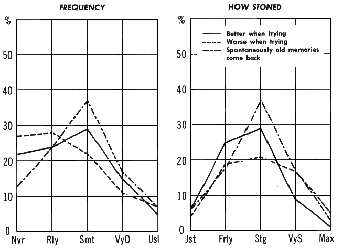 |
| Figure 14-1. INTOXICATION EFFECTS ON LONG-TERM MEMORY Note.—For guide to interpreting the "How Stoned" graph, see note on Figure 6-1. |
Aside from consciously trying to recall things, a common effect is "I spontaneously remember things I hadn't thought of in years, more so than straight (does not apply to consciously trying to remember things)" (13%, 24%, 37%, 17%, 7%). This is more frequent among the young users (p <.05). It begins to occur at the Strong levels (6%, 18%, 37%, 17%, 3%).
The relationships of these three aspects of long-term memory are shown in Figure 14-1. Spontaneously remembering the past occurs more frequently (p <.01) than recall becoming poorer, and recall becoming poorer occurs at higher levels of intoxication than recall becoming better (p <.05).
Comments from my informants suggest that the nature of poor recall is one of selection; many memories are available, but they are often the wrong ones, not those the user wants.
Intermediate-and Short-Term Memory
A very characteristic effect of marijuana intoxication is "My memory span for conversations is somewhat shortened, so that I may forget what the conversation is about even before it has ended (even though I may be able to recall it if I make a special effort)" (3%, 7%, 29%, 49%, 11%). It begins to occur at Strong and Very Strong levels (4%, 15%, 39%, 30%, 8%). Heavy Total users need to be more intoxicated to forget the start of the conversation (p <.05).Going from intermediate-to short-term memory, a common effect is "My memory span for conversations is very shortened, so that I may forget what the start of a sentence was about even before the sentence is finished (although I may be able to recall it if I make a special effort)" (8%, 24%, 31%, 31%, 5%). This drastic shortening of memory span begins to occur at the Strong and Very Strong levels (3%, 9%, 28%, 29%, 22%), with males needing to be more intoxicated than females to experience this (p <.05).
In spite of this drastic shortening of immediate memory, it is also a common effect that "I can continue to carry on an intelligent conversation even when my memory span is so short that I forget the beginnings of what I started to say; e.g., I may logically complete a sentence even as I realize I've forgotten how it started" (6%, 20%, 43%, 24%, 5%). This effect also begins to occur at the Strong and Very Strong levels (5%, 13%, 33%, 29%, 9%). The college-educated experience this beginning at higher levels than the Professionals (p <.05), and the Weekly users at higher levels than the Daily or Occasional users (p <.05).[2]
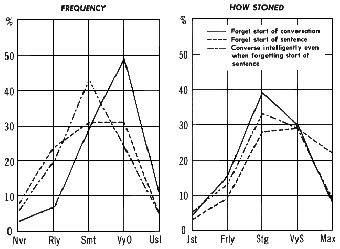 |
| Figure 14-2. INTERMEDIATE-AND SHORT-TERM MEMORY Note.—For guide to interpreting the "How Stoned" graph, see note on Figure 6-1. |
The relationships of these three alterations of intermediate- and short-term memory are presented in Figure 14-2. Forgetting the start of the conversation occurs more frequently than forgetting the start of one's sentence (p <.0005) or than being able to converse despite a shorter memory span (p < .0005). Forgetting the start of one's sentence occurs at higher levels than forgetting the start of the conversation (p <.01), and forgetting the start of one's sentence is rated as beginning at somewhat higher levels than being able to converse intelligently despite a shortened memory span (p <.05).[3]
Two related items dealt with elsewhere also illustrate the shortening of intermediate-and short-term memory. Finding that thoughts slip away before they can quite be grasped (Chapter 15) occurs less frequently than either forgetting the start of the conversation (p <<.0005) or the start of one's sentence (p <.01), and at intoxication levels midway between these two phenomena, albeit not significantly different from either of them. Forgetting to finish a task one has started (Chapter 17) occurs more often than forgetting the start of one's sentence (p <.01), but with about the same frequency as forgetting the start of the conversation. It occurs at lower levels of intoxication than forgetting the start of the conversation (p <.01) and much lower levels than forgetting the start of one's sentence (p <.0005).
In sum, there is often an increasing shortening of intermediate- and short-term memory span with increasing levels of intoxication, as much as forgetting the start of a sentence one is speaking at Strong and Very Strong levels, but it is commonly felt that this does not necessarily have any effect on the intelligibility of the user's conversation.
False Memories
A mild version of a user's memory playing him false is "I think I've said something when actually I've only thought about saying it, more so than when straight." This is a common effect (18%, 24%, 36%, 19%, 3%), which may occur at the Strong and Very Strong levels (3%, 9%, 26%, 34%, 8%). Users of Psychedelics report it as occurring less often (p <.05) and at higher levels of intoxication (p <.05) than Non-users. Light Total users experience this mistake more frequently (p <.05, overall), and Weekly users need to be more intoxicated to experience this than either Daily or Occasional users (p <.01, overall)."I think something is a memory when it turns out to be a fantasy, something I just made up but fooled myself into thinking was a memory at the time (not the same as déjà vu)" is a rare effect (47%, 27%, 20%, 3%, 0%),[4] which may occur at the very high levels of intoxication (3%, 6%, 13%, 17%, 8%). Light Total users need to be more intoxicated for this (p <.05).
The experience of déjà vu (Chapter 9), a common effect beginning to occur at the Strong levels of intoxication, has already been described; this is another instance of poor operation of the memory process, for either a current situation falsely has the quality of "memory" attached to it, or an actual memory is not being completely labeled as a memory. It seems to feel like a memory without really seeming to be one.
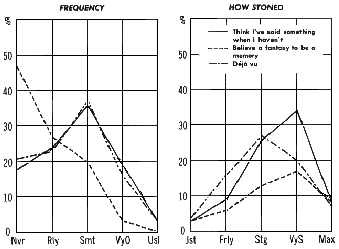 |
| Figure 14-3. FALSIFICATION OF MEMORIES Note.—For guide to interpreting the "How Stoned" graph, see note on Figure 6-1. |
The relationships between these three falsifications of memory functioning are shown in Figure 14-3. Believing a fantasy to be a memory occurs much less frequently than thinking one has said something when he has not (p <.0005) ordéjà vu. Although déjà vu occurs at somewhat lower levels of intoxication than the other two effects, the differences do not reach statistical significance (p <.10 at the greatest).
Thus while the "quality" attached to contents of consciousness that identifies them as a memory may be frequently affected by marijuana intoxication, it is seldom that this is affected strongly enough for the user to actually mistake a fantasy for a memory, i.e., he may frequently experience things seeming like memories but he does not necessarily believe it.
Memory for Periods of Intoxication
If memory functions during the intoxicated state seem to alter, what happens to the memories of the intoxicated state?"My memory of what went on while I was stoned is good afterwards, better than if I had been straight all the time" is a common effect (19% 25%, 31%, 14%, 9%), which begins to occur at the Moderate and Strong levels (13%, 24%, 25%, 13%, 1%). It is reported as occurring more frequently by females (p <.05), and by the College-educated (p <.05). The Daily and Weekly users have this improved memory more frequently than the Occasional users (p <.01, overall).
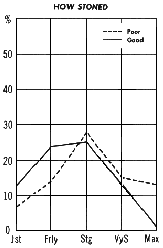 |
| Figure 14-4. MEMORY FOR PERIODS OF INTOXICATION Note.—For guide to interpreting the "How Stoned" graph, see note on Figure 6-1. |
The converse, "My memory of what went on while I was stoned is poor afterwards compared to what I would have remembered had I been straight" is also a common effect (18%, 24%, 24%, 16%, 17%), which begins to occur at Strong levels (7%, 14%, 28%, 15%, 13%). It occurs as frequently as improved memory, but at higher levels of intoxication (p <.0005), as shown in Figure 14-4.
Comments from informants make it clear that a good deal of the poor memory for periods of intoxication is not ordinary forgetting but what has been termed "state-specific memory." The events of the intoxicated state are stored in memory, but they cannot be retrieved in an ordinary state of consciousness. The next time the user becomes intoxicated, however, he can remember many of the things from previous periods of intoxication that he could not remember in his ordinary state.
Thus the forgetting of periods of intoxication are a combination, in unknown degree, of genuine forgetting (no initial storage and/or no possible way of retrieval) and state-specific storage of memories.
A specific aspect of memory for periods of intoxication relates to the results of reading during such periods.
"If I read while stoned, I remember less of what I've read hours later than if I had been straight" is a common effect (15%, 11%, 19%, 14%, 29%), which may begin at Moderate levels of intoxication (13%, 29%, 23%, 5%, 1%). It is experienced less frequently by Meditators and the Therapy and Growth group (p <.05, overall) and more frequently by the younger users (p <.01).
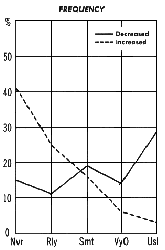 |
| Figure 14-5. MEMORY OF READ MATERIAL |
Figure 14-5 shows that decreased memory occurs much more frequently than increased memory (p <<.0005). The levels of intoxication do not differ significantly.
ADDITIONAL EFFECTS
"I remember the most obvious things and laugh to think I could have forgotten them" (Rarely, Strongly)."Relive childhood experiences" (Usually, Fairly).
LEVELS OF INTOXICATION FOR MEMORY PHENOMENA
The overall relation of various phenomena to levels of intoxication is shown in Figure 14-6. The overall ordering is highly significant (p < <.0005).| Just | Fairly | Strongly | Very Strongly | Maximum | |||||
| |||||||||
| FORGET START OF SENTENCE | |||||||||
| THOUGHTS SLIP AWAY BEFORE GRASPED | |||||||||
| THINK SAID SOMETHING WHEN HAVEN'T | |||||||||
| CONVERSE INTELLIGENTLY DESPITE SHORTENING OF MEMORY SPAN | |||||||||
| FORGET START OF CONVERSATION | |||||||||
| POOR MEMORY FOR PERIODS OF INTOXICATION | |||||||||
| Déjà Vu | |||||||||
| SPONTANEOUSLY RECALL THINGS LONG FORGOTTEN | |||||||||
| OFTEN FORGET TO FINISH SOME TASK | |||||||||
| EASILY SIDETRACKED | |||||||||
| WORSE LONG-TERM MEMORY | |||||||||
| BETTER LONG-TERM MEMORY | |||||||||
| GOOD MEMORY FOR PERIODS OF INTOXICATION | |||||||||
| REMEMBEER LESS OF WHAT IS READ | |||||||||
| REMEMBER MORE OF WHAT IS READ * | |||||||||
| Just | Fairly | Strongly | Very Strongly | Maximum | |||||
At the lowest level, memory for material read is infrequently improved, but it commonly begins getting worse by the Fair level of intoxication. Moving up toward Strongly intoxicated, memory for periods of intoxication is good, but long-term memory may become better or worse, depending on (currently unknown) psychological variables. Memory becomes somewhat erratic and impaired from the Strong level up; while very old memories may spontaneously return, the user may easily get distracted and forget what he set out to do. Moving toward Very Strongly, intermediate-term memory begins to shorten, so that the start of one's conversation may be forgotten before it is finished (although this is generally not felt to impair conversation significantly), and the user may eventually find himself forgetting the beginnings of his sentences. Most of these memory tricks and shortenings are quite apparent to the user, and many users exert effort to compensate for them. At the Very Strong level the user may (rarely) not be aware of the tricks of his memory functioning and temporarily mistake fantasies for actual memories.
MODULATING FACTORS
The effects of relatively linear background factors are summarized in Table 14-1.Users with more drug experience seem less prone to tricks of memory, experiencing several of them less frequently and at higher levels of intoxication. The older users show a similar trend.
Several effects of background factors were not linear. The younger users were more variable on level of intoxication for worsened long-term memory. The Weekly users can be more intoxicated and still converse intelligently despite memory problems than can the Occasional or Daily users, as well as needing to be more intoxicated to think they've said something when they've only thought about it.
| BACKGROUND FACTORS | EFFECTS | |
|---|---|---|
| More Drug Experience | More frequent: Recall more of material read Good memory for periods of intoxication Easily sidetracked More intoxicated for: Forget start of conversation Think said something when haven't | Less frequent: Thoughts slip away Think said something when haven't Less intoxicated for: Mistake fantasy for memory |
| Older | Less frequent: Easily sidetracked Spontaneously remember long-past events Recall less of material read | |
| More Educated | Less frequent: Easily sidetracked Worse long-term memory Good memory for periods of intoxication Less intoxicated for: Easily sidetracked Converse intelligently despite forgetting | |
| Males | More intoxicated for: Forget start of sentence | Less frequent: Good memory for periods of intoxication |
| Meditation | Less frequent: Recall less of material read | |
| Therapy & Growth | More frequent: Recall more of material read | Less frequent: Recall less of material read |
Summary
While very low levels of intoxication may not affect or even may slightly potentiate memory, in the Moderate and higher levels of intoxication there are strong alterations of memory functioning. There is an increasing shortening of memory span, up to the point where a user may forget the start of a sentence he is speaking. Users are generally aware of this span shortening and try to compensate for it in various ways—apparently successfully, as it is a common experience for users to feel they can converse intelligently in spite of this shortening of memory span. State-specific memory is also experienced, i.e., happenings of one intoxication period, which were unrecallable in the subsequent ordinary state of consciousness, are recallable the next time the user again becomes intoxicated.Footnotes
1. The terms long-, intermediate-, and short-term memory are not used in an exact technical sense in this chapter, but more generally to indicate memory span over years or days, minutes, and seconds.2. My informants indicate that this is an objective effect, for many of them have had the experience of talking to a straight person while they were intoxicated, forgetting the start of many of their sentences, but having no indication from the straight person that their speech was noticeably impaired. Whether this says something about the intoxicated state or the intelligence required to carry on normal conversation is an interesting question.
3. Being able to converse intelligently even though the beginnings of one's sentence may be forgotten, should, strictly speaking, occur at the same levels of intoxication as forgetting the start of one's sentence. This was not exactly so in the last difference mentioned above, probably because the slight ambiguity in the wording of the first question allowed it to include somewhat less drastic shortenings of memory span. (back)
4. The rounding-off process lets the figures in Never and Rarely add up to only 74 percent here, but the originals round off to 75 percent, thus the "rare" classification.
Chapter 15. Cognitive Processes: Thought
THE ABSORBINGNESS, intensity, and peculiarities of thought are highly valued by users of marijuana as a better or more efficient way of thinking; thus the common use of the phrase "being high" for describing marijuana (or other psychedelic drug) intoxication implies that the thoughts and experiences are more profound, more insightful. In this chapter we shall consider the absorbingness of intoxicated thinking, its orientation, the change in the quality of thought, and its experienced consequences.
MAJOR EFFECTS
Absorption in Thought
A common experience is "I can get so wound up in thoughts or fantasies that I won't notice what's going on around me or won't hear someone talking to me unless they attract my attention forcibly" (9%, 21%, 40%, 23%, 6%). This is experienced more frequently by the younger users (p <.05) and by the College-educated (p <.01) and less frequently by Users of Psychedelics (p <.05). It generally occurs at the Strong and Very Strong levels of intoxication (3%, 9%, 33%, 32%, 12%), with Light and Moderate Total users experiencing it at lower levels than the Heavy Total users (p <.05, overall).This kind of extreme absorption can apparently occur without some physical actions being stopped: "I can get so wound up in thoughts or fantasies while doing some physical task or job that I lose awareness of doing it, yet suddenly find that I have finished the physical task even though I lost track of it mentally." This is also a common experience (17%, 16%, 42%, 21%, 4%), more so among the College-educated than among the Professionals (p <.05). When experienced, it begins most frequently at the Strong and Very Strong levels (3%, 11%, 38%, 25%, 5%). Moderate Total users may experience this absorption at somewhat lower levels of intoxication (p <.05, overall).
An essentially similar common effect, getting so lost in fantasy that it takes a while to reorient, has already been mentioned in Chapter 9.
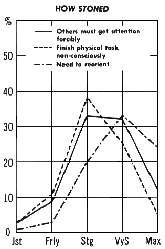 |
| Figure 15-1. INTENSITY OF ABSORPTION IN THOUGHT Note.—For guide to interpreting the "How Stoned" graph, see note on Figure 6-1. |
Although these three ways of being lost in thought occur with about equal frequency, they do form a continuum of absorption with respect to level of intoxication. Finishing a physical task without awareness of what one is doing occurs at lower levels than being so absorbed that others must attract one's attention by rather forcible means, albeit not significantly so; while having been so absorbed that reorientation is needed afterwards occurs at higher levels than finishing a task nonconsciously (p <.0005) or than needing to have one's attention gotten forcibly (p <.01). These differences are shown in Figure 15-1.
Blank Periods
In spite of the absorbingness of thought, and the changes in its nature discussed below, it also seems possible for thought to cease for periods: "I suddenly realize that nothing has been happening for a long time; my mind has been blank and nothing has been going on." This is an infrequent effect (31%, 33%, 27%, 5%, 0%), especially among Users of Psychedelics (p <.05), which occurs at very high levels (2%, 4% 18%, 27%, 11%).Occurring significantly less frequently (p <.0005) is the rare effect of prolonged blank periods: "My mind goes completely blank for long periods (15 minutes or more); even though I'm not asleep, I have no thoughts or images or anything going on in my mind" (56%, 27%, 13%, 2%, 0%), also a phenomenon of the very high levels of intoxication for those who could rate it (1%, 2%, 8%, 16%, 13%). Females experience prolonged blank periods more frequently than males (p <.05). The young and the College-educated need to be more intoxicated to experience prolonged blanks than the older users (p <.01) or the Professionals (p < 05).
As discussed in Chapter 20, it is possible that these prolonged blank periods are actually periods of sleep with sudden onsets and terminations, even though the users do not label them as such.
Insights
The content of thought when intoxicated is commonly felt to be insightful into one's own psychological processes and those of others. "Spontaneously, insights about myself my personality, the games I play come to mind when stoned and seem very meaningful" is a characteristic effect (3%, 9%, 31%, 40%, 15%), which begins to occur at Moderate to Strong levels of intoxication (7%, 28%, 37%, 17%, 4%). It is reported as occurring at lower levels of intoxication by Users of Psychedelics (p <.01). One would assume that, if insights characteristically come spontaneously while intoxicated, adding conscious effort to the process would help it. "If I deliberately work on it, I can have important insights about myself my personality, the games I play," while a common effect (6%, 17%, 31%, 23%, 19%), occurs less frequently than spontaneous insights (p < .05), as shown in Figure 15-2. Whether this means that the users do not deliberately try to have insights very often or whether they try but it does not work as well as letting insights occur spontaneously is unknown, although my informants' comments incline me to the former hypothesis. Deliberate insights also begin to occur at the Moderate to Strong levels of intoxication (12%, 26%, 34%, 9%, 5%).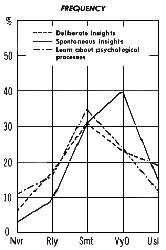 |
| Figure 15-2. INSIGHTS INTO SELF AND OTHERS |
Insights into others, mentioned briefly in Chapter 12, are indicated by "I learn a great deal about psychological processes, what makes people tick, i.e., general knowledge about how the mind works (as opposed to specific insights about yourself)." This is also a common effect (11%, 16%, 35%, 24%, 12%), which occurs at Moderate to Strong levels (7%, 21%, 39%,11%,2%). Heavy Total users experience it at lower levels of intoxication (p <.05, overall). As shown in Figure 15-2, it occurs less frequently than spontaneous insights about oneself (p <.01), but with the same frequency as deliberate insights into oneself. Levels of intoxication do not differ for these three phenomena.
Orientation of Thought
Let us now consider more specific ways in which cognitive processes alter."I give little or no thought to the future; I'm completely in the here-and-now" is a characteristic effect (3%, 10%, 34%, 32%, 21%), reported more frequently by Light Total users than by Moderate or Heavy Total users (p <.01). It begins to occur at Moderate to Strong levels (11% 21%, 39%, 17%, 5%), at lower levels for Meditators (p <.05, overall). What may be a consequence of this increased here-and-now-ness is "I do things with much less thought to possible consequences of my actions than when straight; i.e., I go ahead and do things without thinking first about 'What will people think? How will this affect me?' etc.," a common effect (14%, 20%, 29%, 24%, 12%). This is also less frequent among Heavy Total users (p<.001, overall). It may occur at Strong levels (9%, 17%, 36%, 17%, 4%), with Users of Psychedelics reporting lower minimal levels (p <.05).
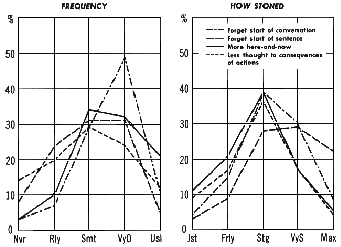 |
| Figure 15-3. HERE-AND-NOW-NESS VS. MEMORY SHORTENING Note.—For guide to interpreting the "How Stoned" graph, see note on Figure 6-1. |
Thinking and Problem Solving
Some aspects of alterations in problem-solving activity concern the dropping of steps in problem solving, the switch to more intuitive modes of thought, increased tolerance of contradictions, and increased use of imagery."I think about things in ways that seem intuitively correct, but which do not follow the rules of logic" is a very common effect (7%, 10%, 36%, 31%, 11%), which begins to occur at Moderate to Strong levels (7%, 26%, 38%, 13%, 3%). Both Meditators and the Therapy and Growth group experience this at lower levels than ordinary users (p <.05, overall).
Less frequent than things seeming intuitively correct (p <.0005), but at similar levels of intoxication, is "In thinking about a problem of the sort that normally requires a series of steps to solve, I can get the answer without going through some of the usual intermediate steps; i.e., I can start to think about the problem and then just arrive at what is clearly the answer, without being aware of the steps in the thought process I would normally be aware of " This is a common effect (26%, 18%, 39% 13%, 1%), more so with females (p<.05). The modal minimal level of intoxication is Strongly (3%, 16%, 27%, 17%, 5%).
"I am more willing to accept contradictions between two ideas or two views of the situation than when straight. I don't get up tight because the two things don't make immediate sense" is a characteristic effect (11%, 8%,24%,33%, 17%), which begins to occur at Moderate levels of intoxication (13%, 33%, 23%, 9%, 1%). Light and Heavy Total users experience this more frequently than Moderate Total users (p <.01, overall).
"When thinking about things while stoned, there are visual images that just automatically go along with the thinking; i.e., I think much more in images instead of just abstract thought" is a very common effect (8%, 15%, 29%, 31%, 15%), which begins to occur at Moderate and Strong levels (7%, 27%, 35%, 15%, 3%).
Efficiency of Thought
Given then that thought commonly is less oriented to the future, is more intuitive, skips intermediate steps, and uses imagery more, is it "higher" or better? The users' feeling about the efficiency of their thought processes while intoxicated were obtained in the next two questions."If I try to solve a problem, it feels as if my mind is working much more efficiently than usual (regardless of how you evaluate your solution later)" is a common effect (13%, 19%, 37%, 17%, 11%), which begins to occur at Moderate to Strong levels of intoxication (12%, 24%, 35%, 9%, 1%).
"If I try to solve a problem, it feels as if my mind is much less efficient than usual (regardless of how you evaluate the solution later)" is also a common effect (12%, 26%, 40%, 11%, 5%), which begins to occur at Strong levels (3%, 17%, 31%, 22%, 7%). It is experienced less frequently by Heavy and Moderate Total users (p <.05, overall), as well as less frequently by Users of Psychedelics (p <.05). One aspect of thinking seeming less efficient is "I can't think clearly; thoughts keep slipping away before I can quite grasp them," a common effect (11%, 18%, 50%, 19%, 2%), which begins at the Strong and Very Strong levels (3%, 13%, 24%, 31%, 14%). This inability to grasp thoughts occurs less frequently in the Weekly users than in the Daily or Occasional users (p <.05, overall). Users of Psychedelics report this less frequently (p <.05). This may be a phenomenon of memory span shortening, rather than of thought per se; i.e., a complex thought may be partially or wholly forgotten before it is completely worked out.
The control of thought, its directability, rather than its graspability, is dealt with in "I feel as if I lose control over my thoughts; they just go on regardless of what I want (without reference to whether you like this or not)." This is also a common phenomenon of the Very Strong levels of intoxication, presented fully in Chapter 17.
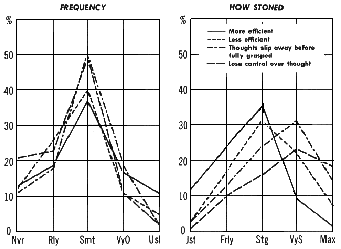 |
| Figure 15-4. EXPERIENCED EFFICIENCY OF THOUGHT PROCESSES Note.—For guide to interpreting the "How Stoned" graph, see note on Figure 6-1. |
The relationships between the direction and grasping of thought and the users' feelings about its efficiency are presented in Figure 15-4. Overall differences in frequency of occurrence and level of intoxication are both significant (p <.001 and p<<.0005, respectively). The feeling that thought is more efficient than usual is somewhat more frequent than the other three phenomena, and definitely occurs at lower levels of intoxication. Thoughts slipping away before grasped and losing control of thought begin to occur mainly at the Very Strong level, with thought seeming more efficient beginning at the Moderate and Strong levels.
The feeling that one's thoughts are more or less efficient in problem solving is, as we all know from experience, not necessarily related to actual performance. To get at this distinction, the following two questions were asked.
"If I work on a problem while stoned, I work more accurately than straight, as judged by later real-world evaluation" is a fairly frequent effect (17%, 29%, 28%, 10%, 3%), which begins to occur at Moderate to Strong levels (13%, 23%, 24%, 7%, 1%). The converse effect, "If I work on a problem while stoned, I work less accurately than straight as judged by later real-world evaluation" is a common effect (9%, 15% 37%, 17%, 8%), which again occurs at Moderate to Strong levels of intoxication (4%, 27%, 25%, 17%, 2%).
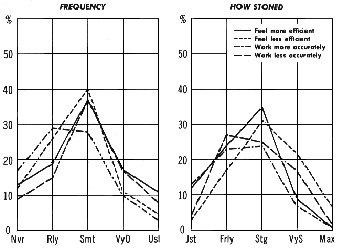 |
| Figure 15-5. EFFICIENCY IN PROBLEM SOLVING: FEELINGS VS. LATER EVALUATION Note.—For guide to interpreting the "How Stoned" graph, see note on Figure 6-1. |
With respect to levels of intoxication, feeling that the mind is more efficient begins at lower levels (p <.0005). A similar trend is apparent in later evaluation, where increased accuracy is rated as beginning at lower levels of intoxication (p <.01). There is a suggestion in the data (p <.10) that decreased accuracy begins to occur at somewhat lower levels of intoxication than the feeling of decreased efficiency.
These relationships suggest that Moderate to Strong levels of intoxication may increase the efficiency of the user in problem solving activity, but higher levels decrease it, judging by both concurrent feelings and retrospective evaluation. A certain amount of false confidence also occurs. Comments by my informants on this indicate that at high levels, what seem to be brilliant chains of thought and insights frequently occur, but are often seen to be false in retrospect. Occasionally they can be very creative, as discussed elsewhere. It is difficult to concentrate and direct thought at these high levels, to keep it centered around a single problem. At low levels direction is relatively easy.
The Sense of Meaning
Although psychologists have never been able to conceptualize it well, thought has dimensions other than being logical or illogical, correct or incorrect by external standards. One of these dimensions is characterized by words such as depth and subtlety."I appreciate very subtle humor in what my companions say, and say quite subtly funny things myself" is a characteristic effect of marijuana intoxication (2%, 5%, 38%, 39%, 15%). Moderate Total users report it most frequently (p <.05, overall). It begins to occur at Moderate levels of intoxication (12%, 40%, 31%, 10%, 2%).
My informants indicate this sense of subtle humor is very pervasive; two intoxicated users can have a conversation that will be incredibly humorous in this subtle way to them, but it might not seem at all humorous to a straight observer. Or an intoxicated user will see very funny implications and connotations in what a straight person is saying, without the latter being aware of them. This general feeling of being able to "tune in" to deeper levels of understanding and meaning is exemplified by the very common phenomenon,"Commonplace sayings or conversations seem to have new meanings, more significance" (4%, 9%, 42%, 35%, 11%), which begins to occur at Strong levels of intoxication (9%, 25%, 43%, 14%, 3%). This is one of the bases of the ability to get involved in very elaborate and subtle social games discussed in Chapter 12.
Another very common effect of marijuana intoxication is "The ideas that come to my mind when stoned are much more original than usual" (5%, 7%, 42%, 33%, 8%). This begins to occur at Moderate to Strong levels (6%, 32%, 41%, 7%, 3%).
A striking example of the apparent facilitation of creative processes in conjunction with marijuana intoxication was offered by one user, a 40-year-old physicist:
I smoke marijuana once or twice a week for recreation, but a couple of times I've started thinking about my work when stoned and had real breakthroughs as a result. Once, when I had been in the process of setting up a new laboratory for several months, I got stoned one evening and started thinking about things at the lab and suddenly had all these ideas popping into my mind of little things I had to do if the laboratory was to function on schedule, little details about equipment that were unspectacular but essential. I listed about twenty ideas in an hour, and every one of them checked out the next day. They were all sorts of things that had been pushed to the back of my mind by more obvious problems in setting up the laboratory. Another time I got thinking about a problem area in my work, and all sorts of theoretical ideas came popping into my head. They fit together into a coherent theory which looked damned good the next morning—I have since published the theory and organized a lot of research around it, to my great advantage.
Thus users find that marijuana intoxication allows a new depth of thought to be experienced, adding meaning, humor, subtlety, and originality to their thought processes on occasion.[1]
Reading
Reading is a type of thought process that is fundamental to modern technological civilization. A very characteristic effect is "I find it difficult to read while stoned" (9%, 6%, 23%, 24%, 33%). This occurs less frequently among Heavy Total users and the Therapy and Growth group (p <.01 and p <.05, overall, respectively). It begins to occur at Moderate and Strong levels of intoxication (11%, 29%, 27%, 13%, 5%). The converse phenomenon, "It is easier to read than usual while stoned" is infrequent (43%, 26%, 20%, 1%, 2%) and occurs at Low and Moderate levels (18%, 20%, 7%, 2%, 1%) among those who could rate it. Moderate and Heavy Total users experience reading ease more frequently (p <.05, overall).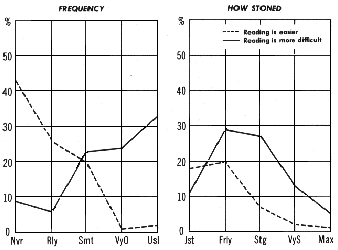 |
| Figure 15-6. EASE OF READING WHILE INTOXICATED Note.—For guide to interpreting the "How Stoned" graph, see note on Figure 6-1. |
The relationships between ease and difficulty of reading are shown in Figure 15-6. Finding reading difficult occurs much more frequently (p <<<.0005). Reading ease is a phenomenon that occurs primarily at the lowest levels of intoxication and is then replaced by reading difficulty (p <.0005).
As discussed in Chapter 14, recall of what has been read while intoxicated is generally poorer after the period of intoxication is over, although it may be somewhat better at very low levels of intoxication. Note also the common effect of visual imagery automatically accompanying reading (Chapter 6).
Thought and Memory
The process of thinking and problem solving involves continual use of memory functions. Sensory input data must be compared with information in memory for recognition and classification, and compared with stored data (values, desires) to see if the input is congruent with the goals of the person. If not, the person must think about what to do, a process involving comparison of the current situation with memories of past situations and the outcomes of various courses of action in those past situations. Memories must be sorted as to degrees of relevance.The shortening of memory span noted in Chapter 14 clearly affects the thought processes, even though some or much of the shortening may sometimes be overcome with special effort on the user's part. Long-term memories may not be as readily available for comparison with the present situation, or the "wrong" old memory may be retrieved.[2] With shortening of intermediate-and short-term memory, the nature of the current situation may not be grasped clearly throughout problem-solving activity, so the thought processes are no longer guided by the goal of being relevant to the situation. Thus decreased efficiency of thought may be a common effect of marijuana intoxication.
This is very much a matter of level, however. At low levels there is little effect on memory, and users often feel their thought processes are more efficient.
When it comes to a consideration of creativity, the shortening of memory span may be a distinct advantage. To the extent that creativity is defined as unlikely chains of associations, a common pragmatic definition in much research on the subject, the shortening of memory span and the erraticness of retrieval will produce unlikely associations and facilitate the creative process. Whether this will appear "genuinely" creative after the intoxication has ended is another question; we usually require a certain coherence and "fit" with other conceptual systems or reality before we consider something creative. The users generally recognize this, enjoying the feeling of creativity that occurs at high levels of intoxication without taking it too seriously until checked out later.
This view of the effects of marijuana on creativity has been expounded in detail elsewhere (Anonymous, 1969).
An intriguing research question then centers around the effects, particularly creative effects, of marijuana intoxication on users who were especially disciplined or had trained themselves to be able to concentrate much more than the normal person. The only account of this sort of thing I know of is by Crowley (in Regardie, 1968), although Krippner's studies of artists influenced by psychedelic drugs is also relevant (Krippner, 1969a, 1969b). Both suggest that a highly disciplined and goal-directed individual can guide a drug experience as he wishes, even at very high levels of intoxication.
ADDITIONAL EFFECTS
Many specific effects of marijuana intoxication on thought processes were offered:"I am aware of multi-leveled thought processes, often not related" (Very Often, Strongly).
"My concentration is longer and stronger" (Usually, Fairly).
"I notice and become engrossed in details" (Usually, Just).
"The ability to see things (society, the world, interpersonal relationships) from a different perspective, unclouded by the fog of our sociological upbringing and the usual ego-trip" (Very Often, Strongly).
"People and irrelevant events seem synchronized" (Very Often, Strongly).
"Considering in ultimate detail every aspect of my own personal involvements" (Usually, Fairly).
"I become very philosophical..." (Usually, Strongly).
"I find myself trying to do something ordinary and pay too little attention so that I do it wrong (e.g., dial the wrong phone number for my home telephone)" (Sometimes, Very Strongly).
"Helpful in putting writings or ideas in perspective" (Sometimes, Fairly).
"I can foresee the future possibilities of my life and its patterns" (Usually, Maximum).
"Discover dramatic new ways of looking at problems when stoned" (Very Often, Strongly).
"See subtle harmony and interplay between diverse subjects, e.g., math and music" (Usually, Strongly).
"Able to comprehend the most abstract concepts" (Very Often, Strongly).
"Thought process is very fast, yet you see things as happening slower than they actually are (at least you think you do)" (Rarely, Very Strongly).
"Very complex connections are made between two or more unrelated events or comments or scenes" (Usually, Fairly).
"Everything (sounds, objects, people, total environment) seems to be just exactly right! All related and perfectly in place" (Usually, Fairly).
"I have a feeling, during and after, of an integration of thoughts and emotions" (Sometimes, Strongly).
"Grasp of total situation widened and strengthened (seeing things whole)" (Sometimes, Very Strongly).
"I am able to sit still and attend to things carefully if I want to" (Very Often, Fairly).
LEVELS OF INTOXICATION FOR THOUGHT PHENOMENA
The various alterations of thought processes and some of the relevant memory process are arranged by level in Figure 15-7. The overall grouping is highly significant (p<<<.0005).| Just | Fairly | Strongly | Very Strongly | Maximum | |||||
| |||||||||
| Prolonged blank periods | |||||||||
| SO ABSORBED IN THOUGHT OR FANTASY THAT NEED TO REORIENT AFTERWARDS | |||||||||
| LOSE CONTROL OF THOUGHT | |||||||||
| BLANK PERIODS | |||||||||
| FORGET START OF SENTENCE | |||||||||
| ABSORBED, ATTENTION MUST BE FORCIBLY GOTTEN | |||||||||
| THOUGHTS SLIP AWAY BEFORE GRASPED | |||||||||
| FORGET START OF CONVERSATION | |||||||||
| FINISH TASK EVEN THOUGH MENTALLY LOST TRACK OF | |||||||||
| MIND FEELS LESS EFFICIENT | |||||||||
| SKIP INTERMEIATE STEPS IN PROBLEM SOLVING | |||||||||
| LESS THOUGHT ABOUT CONSEQUENCES OF ACTIONS | |||||||||
| MORE HERE-AND-NOW | |||||||||
| INSIGHTS INTO OTHERS | |||||||||
| NEW SIGNIFICANCE TO COMMONPLACE CONVERSATIONS | |||||||||
| SPONTANEOUS INSIGHTS INTO SELF | |||||||||
| WORK LESS ACCURATELY | |||||||||
| THOUGHT ACCOMPANIED BY VISUAL IMAGES | |||||||||
| THOUGHT MORE INTUITIVE | |||||||||
| HARDER TO READ | |||||||||
| IDEAS MORE ORIGINAL | |||||||||
| DELIBERATE INSIGHTS INTO SELF | |||||||||
| MIND FEELS MORE EFFICIENT | |||||||||
| APPRECIATE MORE SUBTLE HUMOR | |||||||||
| PLAY ELABORATE GAMES | |||||||||
| WORK MORE ACCURATELY | |||||||||
| MORE VISUAL IMAGERY WHEN READING | |||||||||
| ACCEPT CONTRADICTIONS MORE READILY | |||||||||
| EASIER TO READ?* | |||||||||
| Just | Fairly | Strongly | Very Strongly | Maximum | |||||
Beginning at the lowest levels of intoxication, we have a "relaxation" of thought such that contradictions are tolerated and feelings of increased subtlety and efficiency are noticed. Moving toward the Strong level of intoxication, reading becomes difficult and the direction of thought becomes less controllable, but the richness of thought continues to increase; it may seem more intuitive, original, and significant, and is commonly accompanied by more visual imagery than usual. The user begins to feel he is less efficient at problem-solving thought and is more oriented to the here-and-now.
Above the Strong level, shortening of memory span begins to affect thinking, so the user may become completely absorbed in the experience of long chains of what seem brilliant thoughts, but not recall where he started from. The intense pull of enhanced sensations and intensified feelings and fantasies at these high levels makes direction of thought difficult. Rarely, blank periods may occur at the very high levels.
MODULATING FACTORS
The effects of relatively linear background variables are summarized in Table 15-1.| BACKGROUND FACTORS | EFFECTS | |
|---|---|---|
| More Drug Experience | More frequent: More subtle humor Easier to read Recall more of material read More intoxicated for: Absorbed, attention must be gotten forcibly Forget start of conversation | Less frequent: Mind goes blank So absorbed need to reorient afterwards More here-and-now Less thought to consequences of actions Mind feels less efficient Thoughts slip away before grasped Harder to read Less intoxicated for: Spontaneous insights Insights into others Less thought to consequences of actions |
| Older | Less frequent: Absorbed, attention must be gotten forcibly Recall less of material read Less intoxicated for: Prolonged blank periods | |
| More Educated | Less frequent: Absorbed, attention must be gotten forcibly Lose track of task, but finish it anyway Less intoxicated for: Prolonged blank periods | |
| Males | More intoxicated for: Forget start of sentence | Less frequent: Prolonged blank periods Skip intermediate steps in problem solving |
| Meditation | Less frequent: Recall less of material read Less intoxicated for: More here-and-now Think intuitively | |
| Therapy & Growth | More frequent: Recall more of material read | Less frequent: Harder to read Recall less of material read |
The effects of greater drug experience form a pattern that suggests that more experienced drug users: (1) get into psychological, insightful material at lower levels; (2) have given up the here-and-now-ness orientation to some extent; and (3) have altered a number of effects that might be detrimental to long-term adaptation to the world. With respect to the latter point, the experienced users more frequently find it easier to read and retain what they read, and less frequently experience blank periods, thoughts slipping away, decreased planning (less thought to consequences of actions), and disorientation from hyper-absorption in thoughts and fantasies; also high absorption and memory span shortening shift to higher levels of intoxication.
SUMMARY
Marijuana intoxication can produce intensified awareness of thought processes such that the user can get very absorbed in his thinking, have insights into himself and others, appreciate very subtle humor, and feel his thoughts are more original, intuitive, and profound. At low levels of intoxication, the user may feel his thought processes are more efficient and accurate; but as he becomes more intoxicated, this may be replaced by a feeling of inability to properly direct his thought processes so that he becomes less efficient at problem-solving activities, although creative thought may continue to be enhanced. Shortening of memory span at high levels of intoxication also makes the direction of thought difficult. Users do not feel that this shortening of memory span or difficulty in consciously directing thought is necessarily a hindrance in coping with the world, however, and may consider the more intuitive approach to thought while "high" superior in many situations. More experienced users are less affected by some of the apparently debilitating changes in thought patterns.Footnotes
1. One of the most intriguing and practically exciting studies of creativity ever carried out (Harman, McKim, Mogar, Fadiman & Stolaroff, 1966) found a substantial enhancement of creativity, both in terms of psychological tests and actual job performance, when carefully prepared subjects (professionals whose work involved creativity, such as designers and physicists) were given moderate doses of LSD in the proper setting. I strongly suspect marijuana could have the same effect under proper conditions and consider this a high research priority.2. "Wrong" is highly situation-specific; retrieving a memory other than the one desired may be seen as non-adaptive, entertaining, or creative, depending on the situation.
Chapter 16. Emotions
MAJOR EFFECTS
Emotional Tone of Intoxication
As might be expected in a group of experienced users, i.e., users who repeat the marijuana intoxication experience over and over, it is a very characteristic effect that "I almost invariably feel good when I turn on, regardless of whether I felt bad before turning on" (5%, 11%, 19%, 31%, 30%). This effect has begun to occur in most users by Moderate levels of intoxication (21%, 33%, 25%, 7%, 1%). The converse effect, "I almost invariably feel bad when I turn on, regardless of how I felt before I turned on" is a rare effect (47%, 36%, 9%, 1%, 1%). In those who could rate it, it generally began at the Moderate level (8%, 15%, 9%, 5%, 7%). Heavy Total users need to be more intoxicated to feel bad (p <.05, overall).Although emotional mood prior to intoxication was overcome in the previous two effects, it is a common effect that "Whatever mood I was in before turning on becomes greatly amplified, so if I felt down I really feel bad and if I felt good I really feel very good" (9%, 18%, 36%, 22%, 14%). This occurs more frequently with the Meditators and the Therapy and Growth groups (p <.05, overall). It begins to occur at Moderate to Strong levels (19%, 22%, 32%, 11%, 2%).
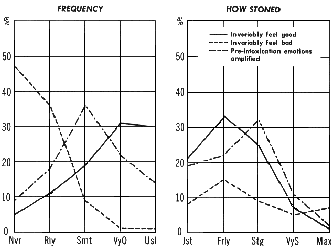 |
| Figure 16-1. QUALITY OF EMOTIONS WHEN INTOXICATED Note.—For guide to interpreting the "How Stoned" graph, see note on Figure 6-1. |
The relationships of these three phenomena are shown in Figure 16-1. Feeling almost invariably good occurs more frequently than pre-intoxication emotions being amplified (p <.0005), and amplified emotions occur more frequently than feeling bad (p <<<.0005). Feeling almost invariably bad occurs at higher levels of intoxication than either feeling good (p<.001) or emotions being amplified (p <.01), primarily because of a few users who indicate Very Strong and Maximum for feeling bad. The difference in levels between feeling good and emotions amplified is not significant.
While the graph suggests that feeling good tends to occur at lower levels and feeling bad at very high levels, comments of pilot subjects and informants indicate that this picture is incomplete. There is a general good feeling that comes from marijuana intoxication at all levels, and this will override mild emotional states the user may have just before becoming intoxicated. If the user has a strong negative mood before becoming intoxicated (whether he is consciously completely aware of it or not), the amplification of emotions common to marijuana intoxication will amplify the negative feelings sufficiently to overcome the good feeling that accompanies intoxication, and he will feel very bad indeed. This latter effect is also modulated by a user's ability to control his intoxication effects; he may be able to suppress the effects of a negative pre-intoxication emotion up to a point, usually by concentrating his attention on pleasurable stimuli and/or not giving attention to his negative feelings. If he is so intoxicated that his control is erratic, and/or the negative pre-intoxication emotion is too strong, he will be unsuccessful and experience the negative emotion in amplified form.[1] The material in Chapter 17 on control is very relevant here.
Giggling
An aspect of the positive emotional tone characteristically associated with marijuana intoxication is "I giggle a lot when stoned; I am silly, even though the situation is not that funny." This is a very common effect (3%, 23%, 47%, 20%, 7%), which occurs more frequently with Females (p <.05). It generally begins to occur at Strong levels (11%, 25%, 36%, 18%, 5%), although Heavy Total users must be more intoxicated to experience it (p <.05, overall). Older users begin giggling at lower levels than younger ones (p <.05).Strength of Emotions
A very common effect of marijuana intoxication is "I feel emotions much more strongly when stoned, so they affect me more" (6%, 13%, 37%, 27%, 17%). The younger users experience this more frequently (p <.05). It begins to occur at the Strong levels (14%, 21%, 39%, 13%, 4%).The converse effect, "I feel emotions much more weakly when stoned, so they have little effect on me" is infrequent (35%, 29%, 21%, 7%, 4%), and occurs less frequently than emotions feeling stronger (p <<.0005). It begins to occur at Moderate to Strong levels (7%, 20%, 21%, 6%, 3%), essentially the same levels as feeling emotions more strongly.
| NUJMBER OF PEOPLE HAVING CRISES | PERCENT OF USERS [a] |
|---|---|
| 0 | 61% |
| 1 | 17% |
| 2 | 11% |
| 3 or more | 10% |
| Note.—These figures cannot be taken as an estimate of the actual number of emotional crises among users of marijuana but only as a maximal estimate because many of the users had been intoxicated together and were probably reporting on the same cases, thus overestimating the incidence of crises to an unknown extent. [a] 1% of the users were lost in the rounding process here | |
Emotional Crises—"Freaking Out"
Given the effect of intoxication in amplifying emotions, combined with some loss of control at very high levels of intoxication, the possibility of the user's being temporarily overwhelmed by intense negative emotions requires investigation. Users term such an event "freaking out."The users were asked, "How many people have you seen freak out' on grass, i.e., have such a catastrophic emotional upset that they needed help of some sort? (Not counting yourself)." Table 16-1 tabulates their answers. It is important to note, however, that these figures cannot be taken as an estimate of the actual number of emotional crises among users of marijuana but only as a maximal estimate; because the questionnaires were passed from acquaintance to acquaintance in the distribution process, a fair number of users had been intoxicated together and so were probably reporting on the same cases of emotional crises and overestimating the incidence of such crises to an unknown extent. Thus most of the users have never seen an overwhelming emotional reaction in other users, and few (10 percent) have seen three or more.
| PERCENTAGE OF PEOPLE HAVING CRISES [a] | PERCENT OF USERS |
|---|---|
| 0 % | 61% |
| </=.01% | 7% |
| </=.1% | 5% |
| </=1% | 16% |
| 2%-4% | 3% |
| 5%-10% | 2% |
| Note.—These figures cannot be taken as an estimate of the actual number of emotional crises among users of marijuana but only as a maximal estimate because many of the users had been intoxicated together and were probably reporting on the same cases, thus overestimating the incidence of crises to an unknown extent. [a] The remainder of the users gave verbal answers that were not classifiable. These were: "very small," "super small," "so small," "almost not worth noting," and "very small percent." Note also that 1% of the users were lost in rounding errors. | |
It is again important to stress that these figures overestimate the incidence to some unknown degree. Nevertheless, the incidence of emotional crises would seem to be very low. Except for 5 percent of the users (one of them a physician), 89 percent of the users estimate the incidence of such reactions as 1 percent or less, and 73 percent as less than a tenth of 1 percent.
Nature of Emotional Crises
Although explanations of the emotional catastrophes were not asked for on the questionnaire, some users added comments. Combining this with various remarks by pilot subjects and informants, it seems that emotional crises fall mainly into two classes. The major one is that of emotionally unstable people or normal people with a major emotional problem on their mind who use marijuana and have their problems amplified. The second, less frequent category is negative emotions of fright and/or confusion, which occasionally result from initial experiences with overdoses of marijuana; i.e., the inexperienced user smokes much more than he knows how to handle and is temporarily confused, disoriented, or frightened by the effects of intoxication. Many users have this happen early in their marijuana-using career. Most apparently learn to control negative effects and/or adapt to unusual effects so as not to be concerned about them; indeed, they come to value them. A few, frightened by the experience, do not use marijuana any more.Outcome of Emotional Crises
With respect to emotional crises in others, the users were asked, "What sort of help did they get? How effective was it?" Of the 53 users answering this question, the majority (64 percent) indicated that friends and other users present simply talked to the disturbed person, reassured him, and calmed him down—a sufficient treatment. Touching the disturbed person was often mentioned in these accounts as particularly effective and reassuring. In 8 percent of the cases the incident simply subsided by itself. In 13 percent some sort of medical or psychological assistance was obtained, although this included such mild treatments as "sleeping it off in the student health center." Miscellaneous methods were used in the other instances.In one of the above cases the user indicated the help was not effective for the disturbed person, but his disturbance was part of a long-term pattern of personality disorder.
Emotional Crises among the Users
The users were asked, "Have you ever freaked out in this way? How many times? What sort of help did you get, and how effective was it?" Because the size of the sample is known, this gives a better estimate of the incidence of this occurrence. Table 16-3 presents the data.| NUMBER OF CRISES | PERCENT OF USERS [a] |
|---|---|
| 0 | 77% |
| 1 | 14% |
| 2 | 3% |
| 3 or more | 3% |
| No response | 3% |
Of the 30 users who had had such an experience, 40 percent indicated it had subsided by itself, and 53 percent that they had been "talked down" by friends, with one user indicating that professional help was needed. One of the users indicated he had deliberately provoked a crisis just to see if he could take it!
Thus in the present sample 20 percent of the users reported one or more experiences of emotional crises, almost all of which subsided by themselves or through the support and reassurance of friends. Only one required professional assistance, giving a serious risk ratio of about 1 percent.[2] The caution should be added, however, that this figure of I percent applies to populations similar to the present one, i.e., users who are experienced and (by implication) well adapted to handling marijuana intoxication. In an unselected population of non-users, the risk ratio for emotional crisis reactions requiring professional help would probably be somewhat higher, depending on the nature of the situations in which marijuana was used.
Physical Components of Emotion
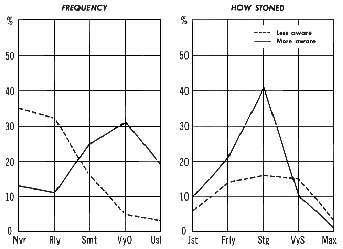 |
| Figure 16-2. BODILY COMPONENTS OF EMOTION Note.—For guide to interpreting the "How Stoned" graph, see note on Figure 6-1. |
ADDITIONAL EFFECTS
"Any hostile action or word is upsetting" (Usually, Fairly)."Relief of anxiety or restlessness" (Usually, Just).
"Presence of anxiety attacks" (Rarely, Strongly).
"Deep concern with injustices all over the world, regardless of my actual participation" (Very Often, Fairly).
"A feeling of depression when coming down" (Usually).
"Extremely sensitive to remarks or criticism" (Usually, Very Strongly).
"My negative feelings upon being disturbed increase, like the feeling toward an alarm clock in the morning" (Usually, Fairly).
"I cry more easily about appropriate things" (Very Often, Strongly). "Little emotional fear of pain" (Usually, Just).
"Annoyed awareness of ego posturings of other stoned people" (Very Often, Fairly).
LEVELS OF INTOXICATION FOR EMOTION
Figure 16-3 groups the various emotional phenomena by levels of intoxication. The overall grouping is highly significant (p <.001).| Just | Fairly | Strongly | Very Strongly | Maximum | |||||
| |||||||||
| LESS AWARE OF BODILY COMPONENTS OF EMOTION | |||||||||
| GIGGLE A LOT | |||||||||
| EMOTIONS FELT MORE STRONGLY | |||||||||
| MORE AWARE OF BODILY COMPONENTS OF EMOTION | |||||||||
| EMOTIONS FELT MORE WEAKLY | |||||||||
| PRE-INTOXICATION EMOTIONS AMPLIFIED | |||||||||
| Almost invariably feel bad when stoned | |||||||||
| AMOST INVARIABLY FEEL GOOD WHEN STONED | |||||||||
As the user becomes intoxicated, he characteristically feels good, a positive emotional tone that persists through all levels of intoxication unless he has strong emotions from his pre-intoxication state that are amplified in the intoxicated state. As he becomes more intoxicated, emotions are sometimes felt less strongly, but more usually emotions are felt more strongly. At Strong levels of intoxication and higher, the bodily components (muscle tensions, viscera feeling, etc.) of emotions may come into awareness, and the positive emotional tone may result in giggling. At very high levels negative emotions are more likely to overcome the positive emotional tone of intoxication if they are very strong or the user has poor control.
MODULATING FACTORS
All background variables had relatively linear effects on emotional phenomena. They are summarized in Table 16-4.| BACKGROUND FACTORS | EFFECTS | |
|---|---|---|
| More Drug Experience | More intoxicated for: Usually feel bad Giggle a lot | |
| Meditation | More frequent: Pre-intoxication mood amplified | |
| Therapy & Growth | More frequent: Pre-intoxication mood amplified | |
| Males | Less frequent: Giggle a lot | |
| Older | Less frequent: Feel emotions more strongly Less intoxicated for: Giggle a lot | |
SUMMARY
Marijuana intoxication characteristically produces a pleasant emotional state in the experienced users in this study. This pleasant feeling tone is sufficient to override the effects of moderate negative emotional states the user may have had just before becoming intoxicated.The emotions, both positive and negative, noble and selfish, which the user does experience while intoxicated, are usually felt more strongly than in his ordinary state, although the personal and situational triggers for eliciting emotion may alter. At high levels of intoxication, where emotions are felt very strongly and decreased control of intoxication phenomena may sometimes occur, a user with a poor personality structure and/or one otherwise normal but involved in high temporary levels of emotional stress may "freak out," be temporarily overwhelmed by negative emotions. This has occurred to 20 percent of the users, but in only one case was it serious enough to require professional assistance; in others, the disturbance subsided by itself, or the reassurance and support of friends was sufficient to alleviate the user's distress.
Footnotes
1. Many informants mentioned that when they know they have a difficult emotional situation on their mind, which they do not feel ready or able to deal with, they will deliberately avoid using marijuana or, if they use it, stay at Low to Moderate levels of intoxication so they can stay out of the problem area. An exception to this is the use of intoxication for gaining insight into personal problems, where the user feels the risk of strong negative emotions is worth taking.2. I use the phrase "serious risk" deliberately here, as I am making a value judgment that being very upset for a few hours is not, per se, a serious risk. Life is full of things that upset us seriously for hours, days, weeks. Requiring professional help to deal with the upset, however, is more serious, and can be considered an indication of "risk."
Chapter 17. Control
MOST CURRENT IDEAS about the nature of marijuana intoxication seem to neglect the fact that since we exercise a fair amount of control over the contents of our minds in ordinary life, it might be expected that control would be similarly exercised by an experienced drug user. This study indicates that much control is exercised by experienced users, primarily by altering the direction and focus of attention. Aspects of this control will be discussed under the general headings of the particular phenomena of intoxication to be controlled and the level of intoxication.
CONTROL OF THE PHENOMENA OF INTOXICATION
Need for Control
In understanding the nature of control over the effects of marijuana intoxication, it is important to note that there is less need felt for tight control: "I find it easy to accept whatever happens; I don't need to control it or feel in control of it." This is a very characteristic effect (2%, 7%, 25%, 29%, 35%), generally manifested by the Moderate level of intoxication (19%, 34%, 27%, 10%, 4%).Concern about and Loss of Control
"I worry about losing control, such that I might do something I wouldn't want to do (regardless of whether you actually lose control)" is a rare phenomenon (36%, 41%, 18%, 4%, 1%), consonant with the characteristic feeling of accepting things. When it occurs, it generally begins at the Very Strong levels for those who could rate it (5%, 7%, 11%, 19%, 15%). Daily users worry about this the least, Weekly users next least, and Occasional users worry the most (p <.05, overall), albeit still infrequently.Some change in behavior that reflects a lowering of normal inhibitions, a change in the criteria for what needs to be controlled, is expressed in the common phenomenon, "My inhibitions are lowered so that I do things I'm normally too inhibited to do (Note: this does not apply to antisocial acts but to acts that are generally acceptable, but that you can't normally do through shyness or the like)" (11%, 19%, 41%, 21%, 7%). This effect has been well expressed elsewhere: "The decrease of socially reinforced inhibitions also accounts for the actions of users which claim public attention: jumping over fireplugs and parking meters, uninhibited dancing (erotic and non-erotic), and playful behavior (which is subtly taboo in our society) [Anonymous, 1969, p. 348]." It generally begins to occur at Moderate to Strong levels (8%, 26%, 31%, 17%, 5%), with the younger users needing to be more intoxicated for this experience (p <.05).
 |
| Figure 17-1. Control Note.—For guide to interpreting the "How Stoned" graph, see note on Figure 6-1. |
Actual loss of control to the point of antisocial actions was the rarest effect found in the present study: "I lose control of my actions and do antisocial things (actions that harm other people) that I wouldn't normally do" (77%, 22%, 1%, 0%, 0%). For the few who could rate this, the minimal intoxication levels peaked at Very Strong (3%, 3%, 3%, 7%, 4%).
The relationships of the lessened need for control, concern over control, and losing control to various degrees are plotted in Figure 17-1, with overall differences highly significant (p < < <.0005, for frequency, p < <.0005 for levels). Feeling less need to be in control of things is most frequent, inhibitions being lowered next most frequent, worrying about loss of control infrequent, and losing control to the point of actions that harm others least frequent. Worrying about losing control and actually losing it to the point of harm are very high level phenomena; inhibitions being lowered is a Moderate to Strong level phenomenon, and feeling less need to control things, a Low to Moderate level phenomenon.
Directions of Fantasies and Thoughts
Prolonged fantasies, enriched with spectacular imagery and intensely absorbing, often seeming as real as nocturnal dreams or life itself, are a main pleasure of marijuana intoxication when the user indulges in them. What sort of control over these can the user exercise, if he is not content to let them develop spontaneously?"I have little or no control over my fantasies; i.e., they flow along spontaneously, and even if I try, I can't change what I'm fantasying about" is an infrequent effect (24%, 29%, 31%, 11%, 3%), albeit more frequent among the College-educated (p <.05) and the younger users (p <.05). It generally begins to occur at the Strong to Very Strong levels of intoxication (3%, 7%, 25%, 19%, 15%).
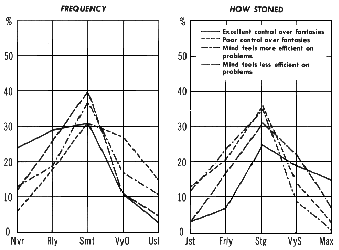 |
| Figure 17-2. CONTROL OVER FANTASIES AND THOUGHTS Note.—For guide to interpreting the "How Stoned" graph, see note on Figure 6-1. |
The converse effect, "I have excellent control over my fantasies: I can make them go in whatever direction I want" is a common effect (6%, 18%, 31%, 27%, 15%), also more frequent among the College-educated (p <.01). It generally begins to occur at Moderate to Strong levels (13%, 21%, 36%, 14%, 3%). A similar effect, "I feel as if I lose control over my thoughts; they just go on regardless of what I want (without reference to whether you like this or not)" occurs with essentially the same frequency and beginning at the same levels of intoxication as not having control over fantasy (21%, 23%, 39%, 11%, 2% for frequency and 1%, 10%, 16%, 23%, 18% for levels).[1]
It is of interest to compare these feelings of control over fantasy with feeling of efficiency of the mind in problem solving (Chapter 15), where ability to direct thought properly is important. Figure 17-2 relates these four phenomena.
Excellent control over fantasies is reported more frequently than the mind's feeling more or less efficient in problem solving (p <.05 in either case) and much more frequently than poor control over fantasy (p <.0005). The latter three phenomena occur with about the same frequency. Both excellent control over fantasy and the mind's feeling more efficient are reported at lower levels of intoxication than poor control or inefficiency (p <.0005 in each case). Poor control over fantasy occurs at somewhat higher levels than the mind's feeling inefficient (p <.05). Thus there is a general feeling of decreasing control at higher levels.
Control of Emotional States
The general ability of users to control emotional states in order to produce a generally pleasant, even ecstatic experience, discussed in Chapter 16, should be mentioned again. As discussed above, there is generally little felt need to control emotions as they are usually pleasant. When control is necessary, it is easier at lower levels of intoxication than at the very high levels.Control of Pain
In Chapter 11 it was reported that pain was easy to tolerate if the user directs his attention elsewhere, but it was also a common effect for pain to be more intense if the user concentrated on it. This not only emphasizes the importance of directing attention in the control of intoxication effects, but the changes in criteria for what to control. Ordinarily most of us go to great lengths to avoid pain; in the intoxicated state, many users find the new experience that comes from concentrating on pain worth the discomfort, at least enough to try it once to see what it's like.External Tasks
A characteristic effect of intoxication is "I often forget to finish some task I've started, or get sidetracked more frequently than when straight" (4%, 9%, 33%, 44%, 9%). This effect begins to occur at Strong levels (7%, 24%, 43%, 16%, 3%). It is experienced more frequently by the younger users (p < .05), the College-educated (p <.05), and the Users of Psychedelics (p <.05). It begins at higher levels for the College-educated (p <.05) and Users of Psychedelics (p <.05).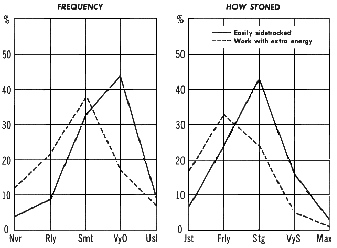 |
| Figure 17-3. CONTROL OVER EXTERNAL TASKS Note.—For guide to interpreting the "How Stoned" graph, see note on Figure 6-1. |
The converse effect, "I can work at a necessary task with extra energy, absorption, and efficiency" is a common effect (12%, 22%, 38%, 17%, 7%), which begins to occur at Moderate levels (17%, 33%, 24%, 5%, 1%). It is experienced more frequently by Users of Psychedelics (p <.001) and begins at higher levels for Heavy Total users (p <.05, overall).
Figure 17-3 shows the relationships between these two levels of control over external tasks. Getting sidetracked is more frequent (p <.0005), while having extra energy and being absorbed in a task occurs at lower levels of intoxication (p < .0005).
Possession
The experience of "possession," the temporary displacement of a person's mind by some outside "spirit" or force, is as old as mankind. Our culture generally rejects the notion of independently existing spirits able to possess someone and control his body; but, phenomenologically, possession is a real experience to those to whom it happens, even though we would consider the "spirit" as simply a manifestation of some split-off part of the person's personality. Two questions dealing with possession were included in the questionnaire as validity scale items, since I had not heard of the phenomenon in pilot interviews. As a number of users reported this phenomenon, the data are given here, as well as a related effect, the user's body seeming to move by itself."I have lost control and been 'taken over' by an outside force or will, which is hostile or evil in intent, for a while" is a rare effect (79%, 14%, 4%, 0%, 0%), which occurs at Very Strong and Maximal levels for the few who could rate it (1%, 1%, 1%, 5%, 9%).
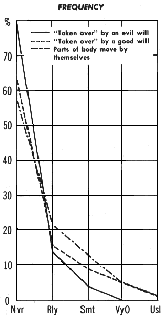 |
| Figure 17-4. "POSSESSION" PHENOMENA |
"I have lost control and been 'taken over' by an outside force or will, which is good or divine, for a while" is also a rare effect (63%, 16%, 9%, 5%, 1%), which occurs at very high levels of intoxication (1%, 3%, 9%, 9%, 7%). The Therapy and Growth group has experienced this more frequently (p <.05, overall).
The extent to which the users may be reporting experiences more aptly classified as "inspiration" rather than the feeling of possession is unknown.
"Parts of my body have moved on their own volition, have done something which I did not will" is also a rare effect (57%, 22%, 13%, 5%, 1%), which occurs more frequently among females than males (p <.05). When it occurs, it generally begins at the very high levels (1%, 3%, 7%, 14%, 10%).
Although the levels-of intoxication for these three possession phenomena were all very high and did not differ significantly, their frequency of occurrence did, as shown in Figure 17-4.
Parts of the body moving by themselves and being possessed by a good force occur with about equal frequency, and both occur more frequently than being possessed by an evil or hostile force (p <.0005 and p <.05, respectively).
CONTROL OF THE LEVEL OF INTOXICATION
While users often are not concerned with what level of intoxication they will reach in any given session, especially if they have no problems on their minds, there are occasions on which a user will not want to get very intoxicated, e.g., if he expects to have to deal with some situation he is not sure he can handle while intoxicated. On the other hand, if the user does not expect to have to deal with straight people or perform complex tasks, he may wish to get as intoxicated as possible. If he wishes to control his level of intoxication, he may do so by controlling the amount of marijuana he smokes[2] and/or by using various psychological techniques to decrease his level (bringing himself "down") or increase his level (bringing himself "up"). The psychological techniques are particularly important when a situation unexpectedly occurs that makes the user feel he should come down.Desire to Get Higher
Sometimes users at a given level of intoxication feel an intense need to become even more intoxicated: "I get a rather compulsive desire to get even higher after a certain stage: I will smoke much more if I can." This is an infrequent effect (26%, 27%, 27%, 15%, 4%), which begins to occur at Moderate to Strong levels (11%, 22%, 24%, 12%, 3%). This desire occurs more frequently among younger users (p <.05), the College-educated (p <.05), Heavy Total users (p <.01, overall), and Daily users (p <.05). The young experience this at lower levels (p <.05).Comments by my informants suggest that the primary motivation behind this effect is the anticipation of greater pleasure from being more intoxicated.
Experience with LSD
The users were asked, "Since taking LSD (or mescaline, peyote, psilocybin, or another major psychedelic drug), I am able to get much higher on grass than I was before." Of the 104 users answering this, 56 said yes and 48 said no, so a substantial portion of users feel their experiences with more powerful psychedelic drugs have enabled them to have more experiences when subsequently using marijuana. Informants commented to the effect that psychedelic drug experiences showed them that certain types of experiences were possible; knowing this, they have then been able to direct attention toward them and attain them with marijuana. This nicely illustrates the nature of potential effects, discussed in Chapter 2, as an underlying model for drug intoxication states.Other Drugs Used to Raise the Level of Intoxication
The users were asked to explain any yes answers to "I have special ways of getting higher besides smoking more grass: (1) other drugs + grass; and (2) special mental techniques." For the first part of this question, 23 percent answered yes, 67 percent no, and 10 percent skipped it. Some users mentioned several drugs they had used in conjunction with marijuana.Ten mentions were made of taking other psychedelic drugs, such as LSD or DMT, in addition to marijuana, and six mentions were made of using hashish, the more potent form of marijuana. That more powerful psychedelics than marijuana should potentiate its effect is not surprising, but one may wonder why the users bother to smoke marijuana if the more powerful drug is available, unless the marijuana effects add some special quality to the more powerful psychedelic.
There were eight mentions of amphetamines for potentiating the marijuana state. Although the method of administration was not mentioned, it is likely that it was by mouth.
Alcohol was mentioned as a potentiator in seven cases, often with indications that the ratio of the two drugs had to be just right, usually a small amount of alcohol with the usual quantity of marijuana smoked.
Among miscellaneous drugs mentioned were amyl nitrate (2) and opium (2).[3]
Mental Techniques for Raising the Level of Intoxication
Thirty-nine percent of the users indicated they had special mental techniques for getting higher. I have classified them into eleven types, with examples of each given below. The number of times various techniques were mentioned in the users' explanations is presented in Table 17-1.
| TYPE OF TECHNIQUE | NUMBER OF TIMES MENTIONED |
|---|---|
| Focusing, concentrating on current activity | 9 |
| Contact with intoxicated companions | 7 |
| Meditation | 7 |
| Direct willing to get higher | 7 |
| Breathing techniques | 6 |
| Music | 4 |
| Letting go, non-striving, relaxation | 4 |
| Fantasy | 4 |
| Inducing positive emotions | 4 |
| Hypnosis | 2 |
| Miscellaneous | 15 |
Focusing, concentrating on current activity, refers to putting all of one's attention on what one is doing or a sensory stimulus one is receiving, e.g., "... staring at one object or some other spot of interest... ," or "cutting out extraneous concerns with past or future, remaining in here-and-now and digging it (grooving)...."
Contact with intoxicated companions refers to the speech and actions of the intoxicated persons' serving to remind the user of higher-level phenomena so that he can experience them, e.g., "thinking like whomever I'm with who's higher," or "talking to stoned people and being with them for a while." "Contact highs," when a user is straight at the time but feels many of the phenomena of intoxication simply by being in close contact with an intoxicated person, were also reported as a common effect (Chapter 12).
Meditation refers to actual use of this word by the user to describe his technique such as "Kundalini yoga—as energy flows up spine and reaches brain, I get higher... ," or "Mantra chanting, zazen."[4]
Direct willing to get higher refers to reports of simply willing to reach a high level of intoxication without any specific mechanisms of such willing being described; e.g., "I move mentally through the same plane as a grass session, and then an LSD session, and finally, beyond both into a higher series of energy levels..."; or "Once fairly stoned I can get as high almost as I like with only the will and the knowledge ('You can fly, Wendy!' said Peter)."
Breathing techniques are illustrated in such comments as "Center on my breathing, close my eyes, and concentrate on getting higher"; or "I hold my breath for 30 seconds at a time and stare at a fixed point of light...." Several users specifically mentioned hyperventilating but noted it produced only a transient alteration in level of intoxication.
Music, especially if it is about other states of consciousness, can be used to get higher; e.g., "Listen to music and relax—especially Donovan—can get high without anything"; or "Listen to music, especially with stereo earphones; all else blocked out, get especially high."
Letting go, non-striving, relaxation are illustrated by "Just let mind loose," or "... allowing same thought processes to develop as when on acid... ," or " ... just relaxing into it, like floating, not striving."
Fantasy refers to imagining specific events that lead into a higher state, such as"... guided daydream[5]...," or "Sometimes smoke a regular cigarette and pass it around pretending it's a joint."
Inducing positive emotions to get higher is illustrated by "I think happy... ," or "... remind myself how incredible it is just to be alive in the first place...."
Hypnosis was mentioned by two users, without further explanation. Aaronson's work (1969) in inducing psychedelic-like states through hypnosis, and Baumann's (1970) technique of training adolescents to re-experience many of the pleasures of marijuana intoxication through hypnotic regression is relevant here.
Lowering the Level—"Coming Down"
"I can 'come down' at will if I need to be straight for a minute to deal with some complicated reality problem (circle the point of highness above which can't do this)" is an extremely characteristic effect of marijuana intoxication (5%, 3%, 18%, 21%, 49%).[6] It is more frequent among males (p <.05), the Professionals (p <.01), and Users of Psychedelics (p < .01). Light Total users report it less frequently than Moderate or Heavy users (p <.05, overall), and the Daily users report it more frequently than the Weekly or Occasional users (p <.05, overall).The Very Strong and Maximal levels were the main ones the users could not come down from at will (2%, 8%, 11%, 33%, 24%). Female users and Users of Psychedelics indicated being able to come down temporarily from higher levels of intoxication (p < .05 and p <.01, respectively).
 |
| Figure 17-5. ABILITY TO "COME DOWN" AT WILL Note.—For guide to interpreting the "How Stoned" graph, see note on Figure 6-1. |
A similar question was asked later in the questionnaire in opposite form, namely, "There is a certain degree of being stoned from above which I cannot come down quickly if I must come down to deal adequately with reality (circle level)."This is a fairly frequent effect (23%, 27%, 21%, 10%, 8%), more so with females (p <.05) and Non-users of Psychedelics (p <.05). The levels above which the user cannot come down quickly are almost exclusively the Very Strong and Maximal levels (0%, 1%, 3%, 21%, 37%), with a higher level being indicated by the Moderate Total users than the Light or Heavy Total users (p <.05, overall).
As shown in Figure 17-5, feeling able to come down at will is far more frequent than feeling unable to (p <<.0005). Being unable to come down quickly when desired is rated as occurring at higher levels of intoxication than the point where the user can come down at will (p <.0005).
Techniques for Coming Down
Twenty-nine percent of the users answered yes to the question "I have special technique(s) for coming down rapidly if I need to be straight quickly (please describe)". Of those answering no, a number offered comments to the effect that they had never experienced a situation they couldn't handle adequately when intoxicated, and so had no need of techniques for coming down.I have classified the 52 techniques described by users in Table 17-2 and illustrated the techniques in each category below.
| TYPE OF TECHNIQUE | NUMBER OF TIMES MENTIONED |
|---|---|
| Direct willing, concentration | 13 |
| Inducing negative emotions | 9 |
| Intense focus on current situation | 8 |
| Acting normal, straight, putting on everyday role | 5 |
| Fantasy, suggestion | 2 |
| Drugs | 2 |
| Miscellaneous | 13 |
Direct willing, concentration refers to simply willing oneself to be normal; e.g., "Just tell myself to straighten up and it works!"; or "... just telling myself straighten out!!!.. ." A number of the techniques put in the miscellaneous category may also have been instances of direct willing, but it was not completely clear that they were.
Inducing negative emotions indicates techniques of frightening oneself and consequently coming down almost immediately, as "I 'freak' myself by imagining the consequences if I 'blow it' "; or "Think of cops and being busted and my family—if that doesn't do it, nothing will" or "Bug my partner, who then bums my trip: I snap back in a flash!"
Intense focus on current situation is illustrated by "... concentrate on the straight task which requires attention"; or "Concentration, deep concentration on the matter at hand can make one straight enough to cope with the situation." Focus on the situation was also used to increase the level of intoxication, but it was a different quality of focus, one of the "Suchness" of things rather than the reality demands they make on the user.
Acting normal, straight, putting on everyday role includes techniques of faking normality or putting on an everyday personality, which then brings the user down. Examples are ". .. put on my work-a-day intellectual persona"; or "By standing up... and lighting up a cigarette (more natural-looking, gives me something to hold my attention) and above all making a determined effort to appear 'straight.'"
Fantasy and suggestion involve creating an image or suggestion that alters the state of consciousness to normal, namely, "I pretend I am walking out of a fog or scene into another scene"; and "Wendy, you're on the ground."
Drugs, Thorazine and Niacin, were mentioned by an engineering student and a psychiatrist. respectively.
ADDITIONAL EFFECTS
"Presence of compulsive behavior or thoughts" (Rarely, Strongly)."I syncopate rhythm when playing the guitar, sometimes unintentionally. This happens only stoned. I find syncopating intentionally difficult" (Very Often, Maximum).
"I get totally absorbed in the process of laughing for minutes at a time; I overreact to any sort of humor" (Usually, Fairly).
"I am suddenly aware of the unreality of my and other's behavior and become convulsed with laughter" (Usually, Fairly).
"Confidence and self-faith are plentiful" (Usually, Just).
"Cannot stop from smiling" (Usually, Fairly). "I enjoy acting out fantasies when stoned" (Very Often, Strongly). "Incessant flowing of verbiage—talking to myself, not out loud" (Very Often, Strongly).
LEVELS OF INTOXICATION FOR CONTROL
Various effects of marijuana intoxication on control are plotted by level of intoxication in Figure 17-6. The overall grouping is highly significant (p <<<.0005).| Just | Fairly | Strongly | Very Strongly | Maximum | |||||
| |||||||||
| NO LONGER CAN COME DOWN AT WILL | |||||||||
| Possessed by evil force | |||||||||
| HIGHEST LEVEL, CAN COME DOWN AT WILL | |||||||||
| Body parts move by themselves | |||||||||
| Possessed by good force | |||||||||
| LOSE CONTROL OVER THOUGHTS | |||||||||
| Worry about losing control | |||||||||
| Harm other people | |||||||||
| POOR CONTROL OVER FANTASIES | |||||||||
| MIND FEELS LESS EFFICIENT IN PROBLEM SOLVING | |||||||||
| EASILY SIDETRACKED ON TASKS | |||||||||
| PAIN EASY TO TOLERATE IF ATTENTION DIRECTED ELSEWHERE | |||||||||
| EMOTINS FELT MORE STRONGLY | |||||||||
| EXCELLENT CONTROL OVER FANTASIES | |||||||||
| STRONGLY INFLUENCED BY COMPANIONS | |||||||||
| INHIBITIONS LOWERED | |||||||||
| COMPULSIVE DESIRE TO GET HIGHER | |||||||||
| EMOTIONS FELT MORE WEAKLY | |||||||||
| MIND FEELS MORE EFFICIENT IN PROBLEM SOLVING ? * | |||||||||
| PRE-INTOXICATION MOOD AMPLIFIED | |||||||||
| LESS NEED TO FEEL IN CONTROL OF THINGS | |||||||||
| EXTRA ENERGY, EFFICIENCY, ABSORPTION IN TASKS ? * | |||||||||
| Just | Fairly | Strongly | Very Strongly | Maximum | |||||
Beginning at the Moderate and Moderate-to-Strong levels, there is characteristically a decreased need to feel in control of things, an increased willingness to trust the situation and let things happen. Some ordinarily inhibited thoughts and behaviors will be allowed, and the user feels his mind is working very efficiently, a feeling that probably reinforces the lessening of need to control things. At the Strong level the user may feel his mind works less efficiently in dealing with problems, and he is easily sidetracked when working on external tasks. His emotions are generally felt more strongly, but he usually feels he has excellent control over his fantasies and so can guide his experiences in very pleasurable directions. Moving up to the Very Strongly intoxicated level, the user may begin to feel lessened control over his thoughts and, less frequently, lessened control over his fantasies, but most users still feel they can come down at will if required. At the highest levels users sometimes feel that they cannot come down at will. They may also, very rarely, feel "possessed" by an external force or will, more often good than evil.
MODULATING FACTORS
The effects of relatively linear background variables are summarized in Table 17-3. Users with more drug experience are less troubled with worries about losing control, and can come down more frequently and from higher levels than other users.One background variable had a non-linear effect. Moderate Total users indicated a higher level above which they could not come down quickly than either Light or Heavy Total users.
| BACKGROUND FACTORS | EFFECTS | |
|---|---|---|
| More Drug Experience | More frequent: Easily sidetracked Extra efficiency, energy for tasks Can come down at will Compulsive desire to get higher More intoxicated for: Easily sidetracked Extra efficiency, energy for tasks Can come down at will | Less frequent: Worry about losing control Can't come down at will |
| Older | More intoxicated for: Compulsive desire to get higher | Less frequent: Poor fantasy control Easily sidetracked Compulsive desire to get higher Less intoxicated for: Inhibitions lowered |
| More Educated | More frequent: Can come down at will | Less frequent: Poor fantasy control Good fantasy control Easily sidetracked Compulsive desire to get higher Less intoxicated for: Easily sidetracked |
| Males | More frequent: Can come down at will | Less frequent: Body parts move by themselves Can't come down at will Less intoxicated for: Can come down at will |
| Therapy & Growth | More frequent: Possessed by good force or will | |
SUMMARY
Although they feel less need to be in control of things and are more willing to trust the situation, experienced marijuana users are able to control the nature of their intoxication experiences to a high degree. Direction of attention is the main way in which this is done; if one concentrates on a desired effect, it may very well occur, while directing concentration away from an undesired effect will frequently allow that effect to fade away.Control is good through most of the range of intoxication, but begins to get poorer for some users at the very high levels.
Most users can generally come down at will from even the Very Strong level of intoxication. Various techniques for coming down include direct willing. inducing fear, or intense focusing on the reality situation that they need to deal with. Many users also can increase their level of intoxication by mental techniques: direct willing, meditating, or associating with others who are more intoxicated. These factors illustrate the importance of situational and psychological variables, over and above drug dosage, in determining level of intoxication at any given time. Also, more experienced drug users have more control of intoxication in general.
Footnotes
1. It is important to note that loss of control can be very pleasurable, according to many of my informants, depending on the personality of the user. They enjoy the spontaneous entertainment quality, the surprise of the unexpected and exotic places their thoughts and fantasies travel to. One informant expressed the enjoyment of loss of control as being analogous to riding a roller coaster; if you're sure the machine is in safe operating condition, you climb on and enjoy the thrills of the ride. Once you're on, it's no longer a question of your control. Thus if the user feels his personality is in good operating condition, he trusts himself to become intoxicated and let the intoxicated state take him where it will. (back)2. With respect to controlling level of intoxication, smoking marijuana is preferred to eating it, as the user can control his level of intoxication very rapidly and precisely. If it is eaten, about three times as much is required for a given level, onset is much slower, duration is longer, offset is longer, and altering level by eating more is risky because of these time delays. Many of the cases of overdosing that my informants knew of resulted from eating marijuana. (back)
3. Some of the users' experience with other drugs used to potentiate or alter the nature of marijuana intoxication results from the fact that some of the marijuana sold in the United States is adulterated with these drugs, either because some customers prefer it (although most of my informants do not like the idea of their marijuana being adulterated with unknown ingredients) or to "potentiate" marijuana that is otherwise too weak in active ingredients to be salable. (back)
4. Mantras are special sounds for meditating on (see Govinda, 1960, e.g.), and zazen refers to the practice of Zen meditation (Suzuki, 1959). (back)
5. The guided daydream is a psychotherapeutic technique for evoking deep levels of imagery. It is used primarily In Europe but is increasingly used in the United States. See Assagioli (1965) Desollle (1965), and Gerard (1961). (back)
6. This widespread ability to "come down," i.e., suppress many of the effects of intoxication at will, raises an interesting methodological question for laboratory studies of the effect of marijuana or its derivatives on various performance measures. If the user believes, as a result of the demand characteristics of the experiment (Orne, 1962; Rosenthal, 1966), that he should do as well as possible, he may come down and try to perform as he would straight. On the other hand, if he thinks it important to perform as an intoxicated person should, he may not only not suppress effects, he may exaggerate them. If the demands are not clear to the subjects, great variability in performance will occur that could wipe out real effects. If the demands have consistent effects on the subjects, but are not clear to the experimenter or the readers of the report on the experiment, error will result from confusing one of many potential effects (drug plus particular demands) with "natural" effects.
===================


No comments:
Post a Comment